
Bovidae is a family of hoofed ruminant mammals in the order Artiodactyla. A member of this family is called a bovid. They are widespread throughout Africa, Asia, Europe, and North America, and are found in a variety of biomes, most typically forest, savanna, shrubland, and grassland. Bovids range in size from the 38 cm (15 in) long royal antelope to the 3.3 m (11 ft) long gaur, which can reach 1,500 kg (3,300 lb) in weight.[1] Over a billion each of domesticated sheep, cattle, and goats, and over 200 million domesticated water buffalo, 14 million domestic yak, and 300,000 domesticated gayal are used in farming worldwide. Many wild species do not have population estimates, though the impala, springbok, and harnessed bushbuck have population sizes of over one million, while several species of bovid are considered endangered or critically endangered with populations as low as 25. One species, the scimitar oryx, was once extinct in the wild, though populations are now recovering. The bluebuck went extinct in the last 200 years, and the aurochs went extinct 400 years ago. A third extinct species, the red gazelle, potentially never existed,[2] and the kouprey is potentially extinct, with no sightings since 1969.[3]
The 146 extant species of Bovidae are split into 53 genera within 9 subfamilies: Aepycerotinae, or the impala; Alcelaphinae, containing the bontebok, hartebeest, wildebeest, and relatives; Antilopinae, containing several antelope, gazelles, and relatives; Bovinae, containing cattle, buffalos, bison, and other antelopes; Caprinae, containing goats, sheep, ibex, serows and relatives; Cephalophinae, or duikers; Hippotraginae, containing the addax, oryx, and relatives; Nesotraginae, or dwarf antelopes; and Reduncinae, or reedbuck and kob antelopes. Extinct species have also been placed into these subfamilies, as well as the extinct Hypsodontinae, Oiocerinae, and Tethytraginae subfamilies. Over one hundred extinct Bovidae species have been discovered, though due to ongoing research and discoveries the exact number and categorization is not fixed.[4]
Conventions
| Conservation status | |
|---|---|
| EX | Extinct (2 species) |
| EW | Extinct in the wild (0 species) |
| CR | Critically Endangered (6 species) |
| EN | Endangered (19 species) |
| VU | Vulnerable (24 species) |
| NT | Near threatened (25 species) |
| LC | Least concern (59 species) |
| Other categories | |
| DD | Data deficient (3 species) |
| NE | Not evaluated (10 species) |
Conservation status codes listed follow the International Union for Conservation of Nature (IUCN) Red List of Threatened Species. Range maps are provided wherever possible; if a range map is not available, a description of the bovid's range is provided. Ranges are based on the IUCN Red List for that species unless otherwise noted. All extinct species or subspecies listed alongside extant species went extinct after 1500 CE, and are indicated by a dagger symbol "†".
Classification
The family Bovidae consists of 146 extant species belonging to 53 genera in 9 subfamilies and divided into hundreds of extant subspecies. This does not include hybrid species or extinct prehistoric species. Additionally, the bluebuck went extinct in the last 200 years, and the aurochs went extinct 400 years ago.
- Subfamily Aepycerotinae
- Genus Aepyceros: one species
- Subfamily Alcelaphinae
- Genus Alcelaphus: one species
- Genus Beatragus: one species
- Genus Connochaetes: two species
- Genus Damaliscus: two species
- Subfamily Antilopinae
- Genus Ammodorcas: one species
- Genus Antidorcas: one species
- Genus Antilope: one species
- Genus Dorcatragus: one species
- Genus Eudorcas: five species
- Genus Gazella: ten species
- Genus Litocranius: one species
- Genus Madoqua: four species
- Genus Nanger: three species
- Genus Neotragus: three species
- Genus Oreotragus: one species
- Genus Ourebia: one species
- Genus Procapra: three species
- Genus Raphicerus: three species
- Genus Saiga: one species
- Subfamily Bovinae
- Genus Bison: two species
- Genus Bos: ten species (one extinct)
- Genus Boselaphus: one species
- Genus Bubalus: five species
- Genus Pseudoryx: one species
- Genus Syncerus: one species
- Genus Taurotragus: two species
- Genus Tetracerus: one species
- Genus Tragelaphus: seven species
- Subfamily Caprinae
- Genus Ammotragus: one species
- Genus Arabitragus: one species
- Genus Budorcas: one species
- Genus Capra: nine species
- Genus Capricornis: four species
- Genus Hemitragus: one species
- Genus Naemorhedus: four species
- Genus Nilgiritragus: one species
- Genus Oreamnos: one species
- Genus Ovibos: one species
- Genus Ovis: seven species
- Genus Pantholops: one species
- Genus Pseudois: one species
- Genus Rupicapra: two species
- Subfamily Cephalophinae
- Genus Cephalophus: fifteen species
- Genus Philantomba: three species
- Genus Sylvicapra: one species
- Subfamily Hippotraginae
- Genus Addax: one species
- Genus Hippotragus: three species (one extinct)
- Genus Oryx: four species
- Subfamily Nesotraginae
- Genus Nesotragus: two species
- Subfamily Reduncinae
Bovids
The following classification is based on the taxonomy described by Mammal Species of the World (2005), with augmentation by generally accepted proposals made since using molecular phylogenetic analysis.
Subfamily Aepycerotinae
| Common name | Scientific name and subspecies | Range | Size and ecology | IUCN status and estimated population |
|---|---|---|---|---|
| Impala
|
A. melampus (Lichtenstein, 1812) Two subspecies
|
Southern Africa (Common impala in green) |
Size: 120–160 cm (47–63 in) long, plus 30–45 cm (12–18 in) tail[5] Habitat: Savanna, shrubland, and grassland[6] Diet: Grass and shrubs[6][7] |
LC
|
Subfamily Alcelaphinae
| Common name | Scientific name and subspecies | Range | Size and ecology | IUCN status and estimated population |
|---|---|---|---|---|
| Hartebeest
|
A. buselaphus (Pallas, 1766) Eight subspecies
|
Scattered sub-Saharan Africa |
Size: 150–245 cm (59–96 in) long, plus 30–70 cm (12–28 in) tail[8] Habitat: Forest, savanna, shrubland, and grassland[9] Diet: Grass[9] |
LC
|
| Common name | Scientific name and subspecies | Range | Size and ecology | IUCN status and estimated population |
|---|---|---|---|---|
| Hirola
|
B. hunteri (P. L. Sclater, 1889) |
Border between Kenya and Somalia |
Size: 120–205 cm (47–81 in) long, plus 30–45 cm (12–18 in) tail[10] Habitat: Savanna, shrubland, and grassland[11] Diet: Grass, as well as forbs[10][11] |
CR
|
| Common name | Scientific name and subspecies | Range | Size and ecology | IUCN status and estimated population |
|---|---|---|---|---|
| Black wildebeest
|
C. gnou (Zimmermann, 1780) |
Southern Africa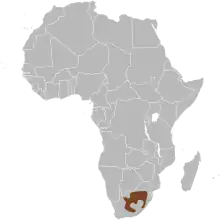 |
Size: 212–242 cm (83–95 in) long, plus 31–45 cm (12–18 in) tail[12] Habitat: Shrubland and grassland[13] Diet: Grass[13] |
LC
|
| Blue wildebeest
|
C. taurinus (Burchell, 1824) Five subspecies
|
Southern and eastern Africa |
Size: 170–240 cm (67–94 in) long, plus 60–100 cm (24–39 in) tail[5] Habitat: Savanna and grassland[14] Diet: Grass[14] |
LC
|
| Common name | Scientific name and subspecies | Range | Size and ecology | IUCN status and estimated population |
|---|---|---|---|---|
| Bontebok
|
D. pygargus (Pallas, 1767) Two subspecies
|
Southern Africa | Size: 140–160 cm (55–63 in) long, plus 30–45 cm (12–18 in) tail[15] Habitat: Shrubland and grassland[16] Diet: Grass and burnt veldt shrubs[16] |
LC
|
| Tsessebe
|
D. lunatus (Burchell, 1823) Six subspecies
|
Scattered sub-Saharan Africa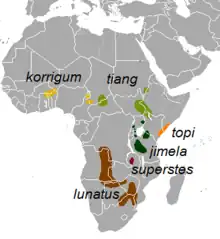 |
Size: 150–230 cm (59–91 in) long, plus 36–42 cm (14–17 in) tail[17] Habitat: Savanna, shrubland, and grassland[18] Diet: Grass[18] |
LC
|
Subfamily Antilopinae
| Common name | Scientific name and subspecies | Range | Size and ecology | IUCN status and estimated population |
|---|---|---|---|---|
| Dibatag
|
A. clarkei (Thomas, 1891) |
Horn of Africa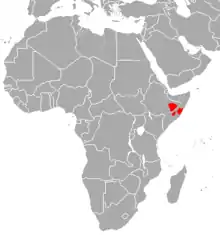 |
Size: 152–168 cm (60–66 in) long, plus 25–35 cm (10–14 in) tail[19] Habitat: Shrubland and grassland[20] Diet: Leaves and shoots[19][20] |
VU
|
| Common name | Scientific name and subspecies | Range | Size and ecology | IUCN status and estimated population |
|---|---|---|---|---|
| Springbok
|
A. marsupialis (Zimmermann, 1780) Three subspecies
|
Southwestern Africa | Size: 120–150 cm (47–59 in) long, plus 14–28 cm (6–11 in) tail[21] Habitat: Savanna, shrubland, grassland, and desert[22] Diet: Shrubs and grass[22] |
LC
|
| Common name | Scientific name and subspecies | Range | Size and ecology | IUCN status and estimated population |
|---|---|---|---|---|
| Blackbuck
|
A. cervicapra (Linnaeus, 1758) Two subspecies
|
India (former range in light green) |
Size: Up to 120 cm (47 in) long[23] Habitat: Forest, grassland, and desert[24] Diet: Grass, as well as leaf litter, flowers, and fruit[24] |
LC
|
| Common name | Scientific name and subspecies | Range | Size and ecology | IUCN status and estimated population |
|---|---|---|---|---|
| Beira
|
D. megalotis (Menges, 1894) |
Horn of Africa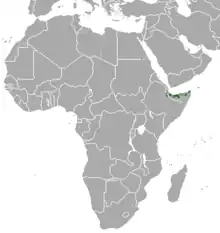 |
Size: 76–87 cm (30–34 in) long, plus 5–8 cm (2–3 in) tail[25] Habitat: Shrubland, and rocky areas[26] Diet: Shrubs[26] |
VU
|
| Common name | Scientific name and subspecies | Range | Size and ecology | IUCN status and estimated population |
|---|---|---|---|---|
| Heuglin's gazelle
|
E. tilonura (Heuglin, 1863) |
Northeastern Africa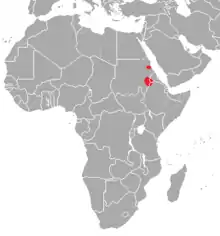 |
Size: 55–120 cm (22–47 in) long, plus 15–27 cm (6–11 in) tail[27] Habitat: Savanna and shrubland[28] Diet: Grass and shrubs[27] |
EN
|
| Mongalla gazelle
|
E. albonotata (W. Rothschild, 1903) |
South Sudan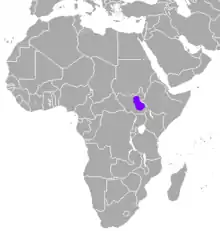 |
Size: 80–120 cm (31–47 in) long, plus 15–27 cm (6–11 in) tail[29] Habitat: Savanna and grassland[30] Diet: Grass and shrubs[29] |
LC
|
| Red gazelle†
|
E. rufina Thomas, 1894 |
North Africa | Size: Unknown Habitat: Unknown Diet: Unknown |
DD
|
| Red-fronted gazelle
|
E. rufifrons (Gray, 1846) Five subspecies
|
Sahel zone in central and western Africa |
Size: 80–120 cm (31–47 in) long, plus 15–27 cm (6–11 in) tail[31] Habitat: Forest, savanna, shrubland, and grassland[32] Diet: Grass and shrubs[31] |
VU
|
| Thomson's gazelle
|
E. thomsonii (Günther, 1884) Two subspecies
|
Eastern Africa |
Size: 80–120 cm (31–47 in) long, plus 15–27 cm (6–11 in) tail[33] Habitat: Savanna and grassland[34] Diet: Grass, as well as forbs and fruit[34] |
LC
|
| Common name | Scientific name and subspecies | Range | Size and ecology | IUCN status and estimated population |
|---|---|---|---|---|
| Arabian gazelle
|
G. arabica (Lichtenstein, 1827) Two subspecies
|
Arabian Peninsula | Size: About 100 cm (39 in) long, plus 9 cm (4 in) tail[35] Habitat: Shrubland and grassland[36] Diet: Cyperus sedges[36] |
VU
|
| Arabian sand gazelle
|
G. marica Thomas, 1897 |
Arabian Peninsula | Size: About 97 cm (38 in) long, plus 15 cm (6 in) tail[37] Habitat: Desert[38] Diet: Grass and forbs[37] |
VU
|
| Chinkara
|
G. bennettii (Sykes, 1831) Six subspecies
|
South Asia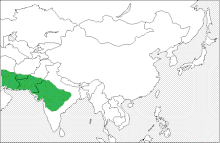 |
Size: 90–120 cm (35–47 in) long[39] Habitat: Forest, shrubland, grassland, and desert[40] Diet: Grass, leaves, crops, and fruit[39] |
LC
|
| Cuvier's gazelle
|
G. cuvieri (Ogilby, 1841) |
Northwestern Africa |
Size: 95–105 cm (37–41 in) long, plus 15–20 cm (6–8 in) tail[41] Habitat: Forest, shrubland, rocky areas, and desert[42] Diet: Leaves and grass[41] |
VU
|
| Dorcas gazelle
|
G. dorcas (Linnaeus, 1758) Six subspecies
|
Northern Africa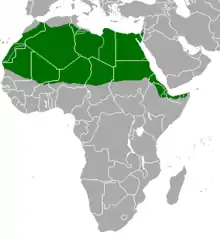 |
Size: 90–110 cm (35–43 in) long, plus 15–20 cm (6–8 in) tail[43] Habitat: Shrubland, grassland, and desert[44] Diet: Acacia tree flowers, leaves, and pods, as well as other fruit and leaves[45] |
VU
|
| Erlanger's gazelle | G. erlangeri Neumann, 1906 |
Arabian Peninsula | Size: 110–125 cm (43–49 in) long, plus 15–20 cm (6–8 in) tail[46] Habitat: Desert[46] Diet: Grass[46] |
NE
|
| Goitered gazelle
|
G. subgutturosa (Güldenstädt, 1780) Three subspecies
|
Western and central Asia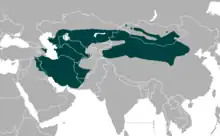 |
Size: 90–115 cm (35–45 in) long, plus 15–20 cm (6–8 in) tail[47] Habitat: Shrubland, grassland, and desert[48] Diet: Grass and low plants[49] |
VU
|
| Mountain gazelle
|
G. gazella (Pallas, 1766) Six subspecies
|
Mediterranean western Asia | Size: 100–125 cm (39–49 in) long, plus 8–13 cm (3–5 in) tail[50] Habitat: Desert and coastal marine[51] Diet: Grass, herbs, and shrubs[52] |
EN
|
| Rhim gazelle
|
G. leptoceros (F. Cuvier, 1842) Two subspecies
|
Scattered northern Africa |
Size: 100–110 cm (39–43 in) long, plus 15–20 cm (6–8 in) tail[53] Habitat: Desert[54] Diet: Desert vegetation[54] |
EN
|
| Speke's gazelle
|
G. spekei Blyth, 1863 |
Horn of Africa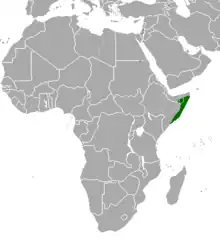 |
Size: 95–105 cm (37–41 in) long, plus 15–20 cm (6–8 in) tail[55] Habitat: Shrubland, grassland, and desert[56] Diet: Grass and leaves[55] |
EN
|
| Common name | Scientific name and subspecies | Range | Size and ecology | IUCN status and estimated population |
|---|---|---|---|---|
| Gerenuk
|
L. walleri (Brooke, 1878) Two subspecies
|
Horn of Africa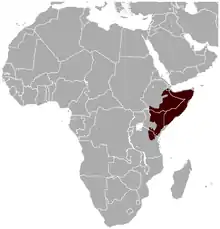 |
Size: 140–160 cm (55–63 in) long, plus 2–4 cm (1–2 in) tail[57] Habitat: Savanna and shrubland[58] Diet: Shrubs[58] |
NT
|
| Common name | Scientific name and subspecies | Range | Size and ecology | IUCN status and estimated population |
|---|---|---|---|---|
| Günther's dik-dik
|
M. guentheri Thomas, 1894 Two subspecies
|
Horn of Africa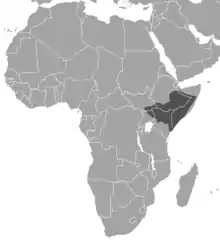 |
Size: 55–65 cm (22–26 in) long, plus 3–5 cm (1–2 in) tail[59] Habitat: Shrubland[60] Diet: Shrubs, leaves, and flowers[61] |
LC
|
| Kirk's dik-dik
|
M. kirkii (Günther, 1880) Four subspecies
|
Southeastern and southwestern Africa |
Size: 52–67 cm (20–26 in) long, plus 3–6 cm (1–2 in) tail[62] Habitat: Shrubland[63] Diet: Leaves, as well as grass, herbs, and sedge[63] |
LC
|
| Salt's dik-dik
|
M. saltiana (Desmarest, 1816) Five subspecies
|
Horn of Africa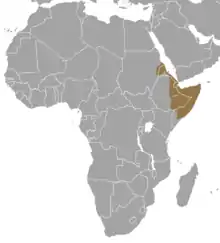 |
Size: 52–67 cm (20–26 in) long, plus 3–6 cm (1–2 in) tail[64] Habitat: Forest and shrubland[65] Diet: Acacia bushes, as well as leaves, buds, flowers, fruit, and herbs[64][65] |
LC
|
| Silver dik-dik | M. piacentinii Drake-Brockman, 1911 |
Horn of Africa | Size: 45–50 cm (18–20 in) long, plus 3–4 cm (1–2 in) tail[66] Habitat: Shrubland[67] Diet: Grass and shrubs[66] |
DD
|
| Common name | Scientific name and subspecies | Range | Size and ecology | IUCN status and estimated population |
|---|---|---|---|---|
| Dama gazelle
|
N. dama (Pallas, 1766) Three subspecies
|
Scattered Saharan Desert and Sahel |
Size: 140–168 cm (55–66 in) long[68] Habitat: Savanna, shrubland, and desert[69] Diet: Shrubs and grass[69] |
CR
|
| Grant's gazelle
|
N. granti (Brooke, 1872) Five subspecies
|
Eastern Africa | Size: 140–166 cm (55–65 in) long, plus 20–28 cm (8–11 in) tail[70] Habitat: Savanna, shrubland, and grassland[71] Diet: Leaves and stems, as well as grass[72][71] |
LC
|
| Soemmerring's gazelle
|
N. soemmerringii (Cretzschmar, 1828) Three subspecies
|
Horn of Africa | Size: 125–150 cm (49–59 in) long, plus 18–23 cm (7–9 in) tail[73] Habitat: Savanna, shrubland, and grassland[74] Diet: Leaves, grass, and herbs[73] |
VU
|
| Common name | Scientific name and subspecies | Range | Size and ecology | IUCN status and estimated population |
|---|---|---|---|---|
| Royal antelope
|
N. pygmaeus (Linnaeus, 1758) |
Western Africa | Size: 38–51 cm (15–20 in) long, plus 5–8 cm (2–3 in) tail[75] Habitat: Forest[76] Diet: Leaves and shoots, as well as fruit and fungi[75] |
LC
|
| Common name | Scientific name and subspecies | Range | Size and ecology | IUCN status and estimated population |
|---|---|---|---|---|
| Klipspringer
|
O. oreotragus (Zimmermann, 1783) Five subspecies
|
Southern and Eastern Africa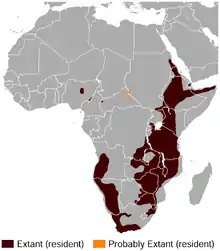 |
Size: 75–115 cm (30–45 in) long[77] Habitat: Savanna, shrubland, rocky areas, and desert[78] Diet: Shrubs[78] |
LC
|
| Common name | Scientific name and subspecies | Range | Size and ecology | IUCN status and estimated population |
|---|---|---|---|---|
| Oribi
|
O. ourebi (Zimmermann, 1782) Eight subspecies
|
Sub-Saharan Africa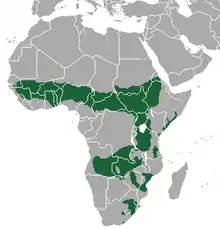 |
Size: 92–110 cm (36–43 in) long[79] Habitat: Savanna and grassland[80] Diet: Grass and shrubs[79] |
LC
|
| Common name | Scientific name and subspecies | Range | Size and ecology | IUCN status and estimated population |
|---|---|---|---|---|
| Goa
|
P. picticaudata Hodgson, 1846 |
Western China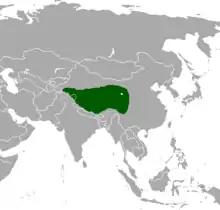 |
Size: 91–105 cm (36–41 in) long, plus 8–9 cm (3–4 in) tail[81] Habitat: Grassland and inland wetlands[82] Diet: Forbs and legumes, as well as grass and sedges[81] |
NT
|
| Mongolian gazelle
|
P. gutturosa (Pallas, 1777) |
Mongolia and nearby central Asia (historical range in light green)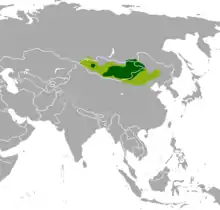 |
Size: 100–130 cm (39–51 in) long[83] Habitat: Grassland and desert[84] Diet: Grass, onions, and shrubs[83] |
LC
|
| Przewalski's gazelle
|
P. przewalskii (Büchner, 1891) Two subspecies
|
Central China | Size: 105–110 cm (41–43 in) long, plus up to 11 cm (4 in) tail[85] Habitat: Grassland and desert[86] Diet: Shrubs and grass[85] |
EN
|
| Common name | Scientific name and subspecies | Range | Size and ecology | IUCN status and estimated population |
|---|---|---|---|---|
| Cape grysbok
|
R. melanotis (Thunberg, 1811) |
Southern Africa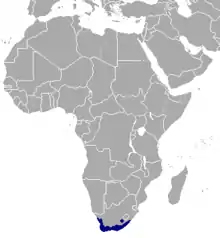 |
Size: 65–80 cm (26–31 in) long, plus up to 4–8 cm (2–3 in) tail[87] Habitat: Shrubland and grassland[88] Diet: Shrubs and grass[88] |
LC
|
| Sharpe's grysbok
|
R. sharpei Thomas, 1897 |
Southeastern Africa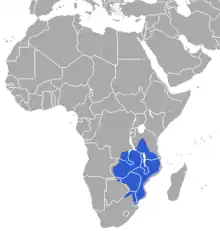 |
Size: 65–75 cm (26–30 in) long, plus 4–8 cm (2–3 in) tail[89] Habitat: Savanna and shrubland[90] Diet: Shrubs and grass[90] |
LC
|
| Steenbok
|
R. campestris (Thunberg, 1811) Four subspecies
|
Southern and southeastern Africa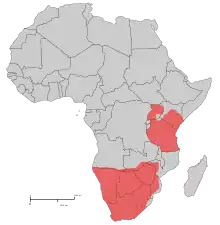 |
Size: 70–95 cm (28–37 in) long, plus 4–6 cm (2–2 in) tail[91] Habitat: Savanna, shrubland, and grassland[92] Diet: Shrubs, geophytes, berries, flowers, and fruit[92] |
LC
|
| Common name | Scientific name and subspecies | Range | Size and ecology | IUCN status and estimated population |
|---|---|---|---|---|
| Saiga antelope
|
S. tatarica (Linnaeus, 1766) Two subspecies
|
Central Asia (historical range in white) |
Size: 108–146 cm (43–57 in) long, plus 6–13 cm (2–5 in) tail[93] Habitat: Grassland and desert[94] Diet: Grass[94] |
NT
|
Subfamily Bovinae
| Common name | Scientific name and subspecies | Range | Size and ecology | IUCN status and estimated population |
|---|---|---|---|---|
| American bison
|
B. bison Linnaeus, 1758 |
Scattered North America |
Size: 210–380 cm (83–150 in) long, plus 43–90 cm (17–35 in) tail[5] Habitat: Forest, savanna, shrubland, grassland, inland wetlands, and desert[95] Diet: Grass, leaves, and roots, as well as sagebrush[5][95] |
NT
|
| European bison
|
B. bonasus Linnaeus, 1758 Three subspecies
|
Scattered Europe and western Asia |
Size: 280–330 cm (110–130 in) long, plus 30–92 cm (12–36 in) tail[97] Habitat: Forest, shrubland, grassland, and unknown[98] Diet: Grass, sedges and herbs, as well as trees and shrubs[99] |
NT
|
| Common name | Scientific name and subspecies | Range | Size and ecology | IUCN status and estimated population |
|---|---|---|---|---|
| Aurochs†
|
B. primigenius Bojanus, 1827 |
Formerly Europe, Asia, and North Africa |
Size: Unknown Habitat: Unknown Diet: Grass[100] |
EX
|
| Banteng
|
B. javanicus d'Alton, 1823 Two subspecies
|
Southeast Asia (possible range in red) |
Size: 190–225 cm (75–89 in) long, plus 65–70 cm (26–28 in) tail[101] Habitat: Forest and grassland[102] Diet: Grass, sedges, herbs, and bamboo, as well as leaves, fruit, flowers, bark, and young branches of shrubs and trees[102] |
EN
|
| Bali cattle
|
B. domesticus Wilckens, 1905 |
Southeast Asia | Size: 190–225 cm (75–89 in) long, plus 65–70 cm (26–28 in) tail[101] Habitat: Forest and grassland[102] Diet: Grass, sedges, herbs, and bamboo, as well as leaves, fruit, flowers, bark, and young branches of shrubs and trees[102] |
NE
|
| Cattle
|
B. taurus Linnaeus, 1758 |
Worldwide |
Size: 150–250 cm (59–98 in) long[103] Habitat: Grassland, shrubland, forest, and desert[100] Diet: Grass[100] |
NE
|
| Gaur
|
B. gaurus Smith, 1827 Two subspecies
|
Southern and southeastern Asia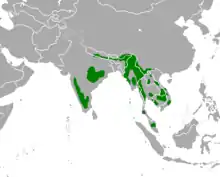 |
Size: 250–330 cm (98–130 in) long, plus 70–100 cm (28–39 in) tail[1] Habitat: Forest, savanna, grassland, and shrubland[105] Diet: Grass as well as leaves, fruit, twigs, bark, and bamboo[105] |
VU
|
| Gayal
|
B. frontalis Lambert, 1804 Four subspecies
|
South Asia | Size: 250–330 cm (98–130 in) long, plus 70–105 cm (28–41 in) tail[106] Habitat: Forest and grassland[106] Diet: Grass, forbs, and leaves[106] |
NE |
| Kouprey | B. sauveli Urbain, 1937 |
Southeast Asia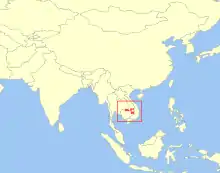 |
Size: 210–223 cm (83–88 in) long, plus up to 100 cm (39 in) tail[108] Habitat: Forest, savanna, and grassland[3] Diet: Grass, sedges, and shrubs[3] |
CR
|
| Wild yak
|
B. mutus (Przhevalsky, 1883) |
Central Asia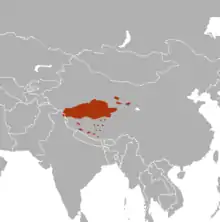 |
Size: 306–385 cm (120–152 in) long, plus up to 60 cm (24 in) tail[109] Habitat: Grassland and desert[110] Diet: Grass and sedges, as well as forbs[110] |
VU
|
| Yak
|
B. grunniens Linnaeus, 1766 |
Central Asia | Size: 145–218 cm (57–86 in) long, plus 60 cm (24 in) tail[111] Habitat: Rocky areas and grassland[112] Diet: Grass, shrubs, and forbs, as well as lichen and moss[112] |
NE
|
| Zebu
|
B. indicus Linnaeus, 1758 |
Asia | Size: 150–250 cm (59–98 in) long[103] Habitat: Grassland, shrubland, forest, and desert[100] Diet: Grass[100] |
NE
|
| Common name | Scientific name and subspecies | Range | Size and ecology | IUCN status and estimated population |
|---|---|---|---|---|
| Nilgai
|
B. tragocamelus (Pallas, 1766) |
Indian subcontinent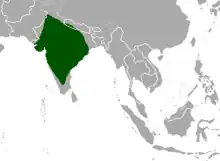 |
Size: 180–200 cm (71–79 in) long[114] Habitat: Forest, shrubland, and grassland[115] Diet: Grass and shrubs[115] |
LC
|
| Common name | Scientific name and subspecies | Range | Size and ecology | IUCN status and estimated population |
|---|---|---|---|---|
| Lowland anoa
|
B. depressicornis (H. Smith, 1827) |
Island of Sulawesi in Indonesia | Size: 122–188 cm (48–74 in) long, plus up to 41 cm (16 in) tail[116] Habitat: Forest[117] Diet: Shrubs[117] |
EN
|
| Mountain anoa
|
B. quarlesi (Ouwens, 1910) |
Island of Sulawesi in Indonesia | Size: 122–153 cm (48–60 in) long[118] Habitat: Forest[119] Diet: Grass and shrubs[119] |
EN
|
| Tamaraw
|
B. mindorensis Heude, 1888 |
Island of Mindoro in the Philippines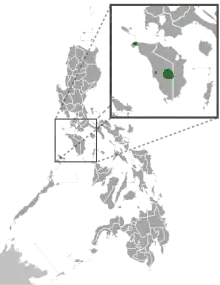 |
Size: Around 220 cm (87 in) long, plus 60 cm (24 in) tail[120] Habitat: Forest, shrubland, and grassland[121] Diet: Grass and young bamboo shoots[121] |
CR
|
| Water buffalo
|
B. bubalis (Linnaeus, 1758) Three subspecies
|
Scattered Asia, Egypt, and South America |
Size: 240–300 cm (94–118 in) long, plus 60–100 cm (24–39 in) tail[122] Habitat: Forest and grassland[122] Diet: Grass, as well as herbs, shrubs, and leaves[122] |
NE
|
| Wild water buffalo
|
B. arnee (Kerr, 1792) Four subspecies
|
Scattered Southeast Asia |
Size: 240–300 cm (94–118 in) long, plus up to 60–100 cm (24–39 in) tail[124] Habitat: Forest, savanna, grassland, and inland wetlands[125] Diet: Grass and sedges, as well as fruit and shrubs[124] |
EN
|
| Common name | Scientific name and subspecies | Range | Size and ecology | IUCN status and estimated population |
|---|---|---|---|---|
| Saola
|
P. nghetinhensis Dung, Giao, Chinh, Tuoc, Arctander, MacKinnon, 1993 |
Annamite Range of Vietnam and Laos |
Size: 143–150 cm (56–59 in) long, plus up to 25 cm (10 in) tail[126] Habitat: Forest[127] Diet: Leaves as well as shrubs[127] |
CR
|
| Common name | Scientific name and subspecies | Range | Size and ecology | IUCN status and estimated population |
|---|---|---|---|---|
| African buffalo
|
S. caffer (Sparrman, 1779) Five subspecies
|
Sub-Saharan Africa |
Size: 240–340 cm (94–134 in) long, plus 75–110 cm (30–43 in) tail[5] Habitat: Forest, savanna, shrubland, grassland, and inland wetlands[128] Diet: Grass[5] |
NT
|
| Common name | Scientific name and subspecies | Range | Size and ecology | IUCN status and estimated population |
|---|---|---|---|---|
| Common eland
|
T. oryx (Pallas, 1766) Three subspecies
|
Eastern and southern Africa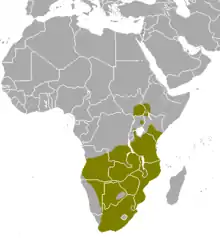 |
Size: 200–345 cm (79–136 in) long, plus 50–72 cm (20–28 in) tail[129] Habitat: Forest, savanna, shrubland, and grassland[130] Diet: Shrubs[130] |
LC
|
| Giant eland
|
T. derbianus (Gray, 1847) Two subspecies
|
Western and central Africa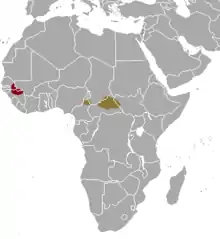 |
Size: 210–345 cm (83–136 in) long, plus 55–70 cm (22–28 in) tail[131][132] Habitat: Forest and savanna[133] Diet: Leaves, shoots, herbs and fruit, as well as grass[133] |
VU
|
| Common name | Scientific name and subspecies | Range | Size and ecology | IUCN status and estimated population |
|---|---|---|---|---|
| Four-horned antelope
|
T. quadricornis (Blainville, 1816) Three subspecies
|
Indian subcontinent |
Size: 80–110 cm (31–43 in) long, plus 10–15 cm (4–6 in) tail[134] Habitat: Forest and shrubland[135] Diet: Grass and shrubs[135] |
VU
|
| Common name | Scientific name and subspecies | Range | Size and ecology | IUCN status and estimated population |
|---|---|---|---|---|
| Bongo
|
T. eurycerus (Ogilby, 1837) |
Western and central Africa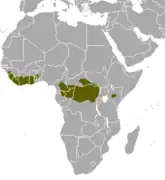 |
Size: 170–250 cm (67–98 in) long, plus 45–65 cm (18–26 in) tail[136] Habitat: Forest and savanna[137] Diet: Shrubs as well as grass[137] |
NT
|
| Greater kudu
|
T. strepsiceros (Pallas, 1766) Three subspecies
|
Central, eastern, and southern Africa |
Size: 180–250 cm (71–98 in) long[5] Habitat: Forest, savanna, shrubland, and desert[138] Diet: Shrubs[138] |
LC
|
| Harnessed bushbuck
|
T. scriptus (Pallas, 1766) Eight subspecies
|
Western and central Africa | Size: 105–150 cm (41–59 in) long, plus 19–25 cm (7–10 in) tail[139] Habitat: Forest, savanna, shrubland, and grassland[140] Diet: Shrubs[140] |
LC
|
| Lesser kudu
|
T. imberbis (Blyth, 1869) |
Eastern Africa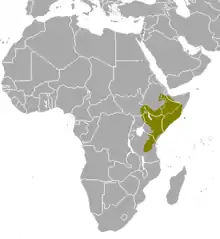 |
Size: 110–175 cm (43–69 in) long, plus 26–30 cm (10–12 in) tail[141] Habitat: Forest, savanna, and shrubland[142] Diet: Tree leaves, shrubs, and herbs[142] |
NT
|
| Mountain nyala
|
T. buxtoni (Lydekker, 1910) |
Central Ethiopia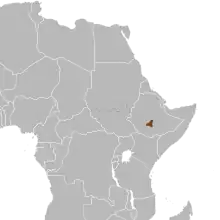 |
Size: 190–260 cm (75–102 in) long[143] Habitat: Forest, shrubland, and grassland[144] Diet: Grass, herbs, and shrubs[143] |
EN
|
| Nyala
|
T. angasii Angas, 1849 |
Southeastern Africa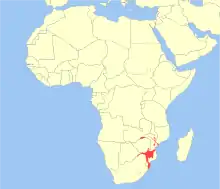 |
Size: 132–198 cm (52–78 in) long, plus 35–55 cm (14–22 in) tail[145] Habitat: Forest, savanna, and shrubland[146] Diet: Leaves and fruit as well as grass[146] |
LC
|
| Sitatunga
|
T. spekii P. L. Sclater, 1863 Five subspecies
|
Central Africa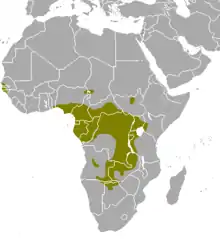 |
Size: 115–170 cm (45–67 in) long, plus 18–30 cm (7–12 in) tail[147] Habitat: Forest, savanna, shrubland, grassland, and inland wetlands[148] Diet: Grass, sedges, and shrubs[148] |
LC
|
Subfamily Caprinae
| Common name | Scientific name and subspecies | Range | Size and ecology | IUCN status and estimated population |
|---|---|---|---|---|
| Barbary sheep
|
A. lervia (Pallas, 1777) Six subspecies
|
Northern Africa | Size: 130–165 cm (51–65 in) long, plus 12–25 cm (5–10 in) tail[149] Habitat: Savanna, shrubland, grassland, rocky areas, and desert[150] Diet: Grass, shrubs, and forbs[150] |
VU
|
| Common name | Scientific name and subspecies | Range | Size and ecology | IUCN status and estimated population |
|---|---|---|---|---|
| Arabian tahr
|
A. jayakari Thomas, 1894 |
Eastern Arabia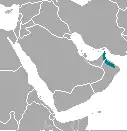 |
Size: 93–95 cm (37–37 in) long, plus up to 8–10 cm (3–4 in) tail[151] Habitat: Shrubland, rocky areas, and desert[152] Diet: Grass, forbs, shrubs, and trees[152] |
EN
|
| Common name | Scientific name and subspecies | Range | Size and ecology | IUCN status and estimated population |
|---|---|---|---|---|
| Takin
|
B. taxicolor Hodgson, 1850 Four subspecies
|
Eastern Himalayas |
Size: 170–220 cm (67–87 in) long, plus 15 cm (6 in) tail[153] Habitat: Forest, shrubland, and grassland[154] Diet: Grass, bamboo shoots, forbs, and leaves[154] |
VU
|
| Common name | Scientific name and subspecies | Range | Size and ecology | IUCN status and estimated population |
|---|---|---|---|---|
| Alpine ibex
|
C. ibex Linnaeus, 1758 |
The Alps |
Size: 130–140 cm (51–55 in) long, plus 12–15 cm (5–6 in) tail[155] Habitat: Grassland, and rocky areas[156] Diet: Grass and herbs, as well as woody plants and cryptogams[156] |
LC
|
| East Caucasian tur
|
C. cylindricornis (Blyth, 1841) |
Caucasus Mountains in eastern Europe | Size: 120–165 cm (47–65 in) long, plus 10–14 cm (4–6 in) tail[157] Habitat: Forest, shrubland, grassland, and rocky areas[158] Diet: Grass, trees, and a variety of other plants[158] |
NT
|
| Iberian ibex
|
C. pyrenaica Schinz, 1838 |
Iberian Peninsula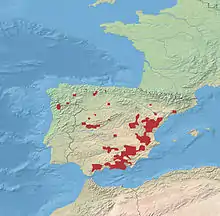 |
Size: 100–140 cm (39–55 in) long, plus 10–15 cm (4–6 in) tail[159] Habitat: Forest, shrubland, and rocky areas[160] Diet: Leaves, acorns, forbs, and grass[159] |
LC
|
| Markhor
|
C. falconeri (Wagner, 1839) Three subspecies
|
Central Asia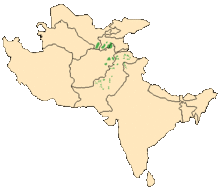 |
Size: 140–185 cm (55–73 in) long, plus 8–14 cm (3–6 in) tail[161] Habitat: Forest, shrubland, and rocky areas[162] Diet: Grass and leaves[162] |
NT
|
| Nubian ibex
|
C. nubiana F. Cuvier, 1825 |
Northern Africa and the Middle East | Size: 105–125 cm (41–49 in) long[163] Habitat: Shrubland, rocky areas, and desert[164] Diet: Wide variety of herbaceous and woody plants[164] |
VU
|
| Siberian ibex
|
C. sibirica (Pallas, 1776) |
Central Asia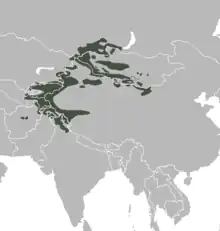 |
Size: 130–165 cm (51–65 in) long, plus 10–18 cm (4–7 in) tail[165] Habitat: Forest, shrubland, grassland, rocky areas, and desert[166] Diet: Grass, as well as herbs and shrubs[166] |
NT
|
| Walia ibex
|
C. walie Rüppell, 1835 |
Northeastern Africa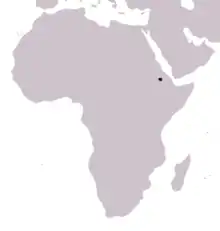 |
Size: 150–170 cm (59–67 in) long, plus 20–25 cm (8–10 in) tail[167] Habitat: Shrubland, grassland, and rocky areas[168] Diet: Shrubs, herbs, lichens, and grass[169] |
VU
|
| West Caucasian tur
|
C. caucasica Güldenstädt, Pallas, 1783 Two subspecies
|
Caucasus Mountains in eastern Europe | Size: 120–165 cm (47–65 in) long, plus 10–14 cm (4–6 in) tail[170] Habitat: Forest, shrubland, grassland, and rocky areas[171] Diet: Grass, trees, and a variety of other plants[171] |
EN
|
| Wild goat
|
C. aegagrus Erxleben, 1777 Five subspecies
|
Western Asia (worldwide distribution of domestic goat in farming) |
Size: 115–170 cm (45–67 in) long[172] Habitat: Forest, shrubland, grassland, rocky areas, and desert[173] Diet: Grass, herbaceous plants, and shrubs, as well as trees[173] |
NT
|
| Common name | Scientific name and subspecies | Range | Size and ecology | IUCN status and estimated population |
|---|---|---|---|---|
| Japanese serow
|
C. crispus (Temminck, 1836) |
Japan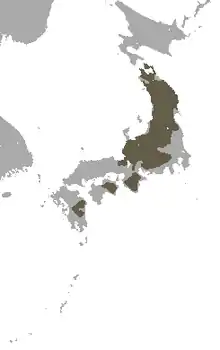 |
Size: Around 130 cm (51 in) long[174] Habitat: Forest, shrubland, and grassland[175] Diet: Leaves, shoots, and acorns[175] |
LC
|
| Mainland serow
|
C. sumatraensis (Bechstein, 1799) Three subspecies
|
The Himalayas and southeastern Asia | Size: 140–155 cm (55–61 in) long, plus 8–16 cm (3–6 in) tail[176] Habitat: Forest, shrubland, grassland, and rocky areas[177] Diet: Leaves and twigs[177] |
VU
|
| Red serow
|
C. rubidus (Blyth, 1863) |
Southeastern Asia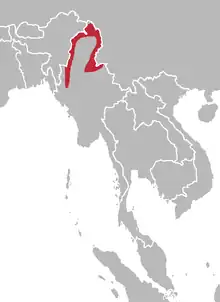 |
Size: 140–155 cm (55–61 in) long[178] Habitat: Forest, shrubland, and rocky areas[179] Diet: Grass, shoots, and leaves[178] |
NT
|
| Taiwan serow
|
C. swinhoei Gray, 1862 |
Taiwan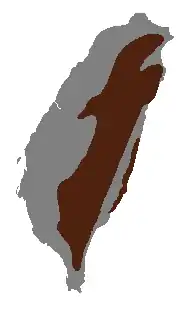 |
Size: 80–114 cm (31–45 in) long, plus 7–12 cm (3–5 in) tail[180] Habitat: Forest, shrubland, grassland, and rocky areas[181] Diet: Grass and shrubs[181] |
LC
|
| Common name | Scientific name and subspecies | Range | Size and ecology | IUCN status and estimated population |
|---|---|---|---|---|
| Himalayan tahr
|
H. jemlahicus (H. Smith, 1826) |
Himalayas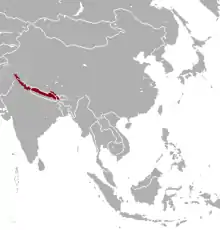 |
Size: 90–140 cm (35–55 in) long[182] Habitat: Forest, shrubland, grassland, and rocky areas[183] Diet: Herbaceous plants and shrubs, grass, and sedges[183] |
NT
|
| Common name | Scientific name and subspecies | Range | Size and ecology | IUCN status and estimated population |
|---|---|---|---|---|
| Chinese goral
|
N. griseus (Milne-Edwards, 1874) Two subspecies
|
Southeastern Asia 178px|alt=Map of range |
Size: 88–118 cm (35–46 in) long, plus 11–20 cm (4–8 in) tail[184] Habitat: Forest, shrubland, and rocky areas[185] Diet: Grass, leaves, twigs, and nuts[185] |
NE
|
| Himalayan goral
|
N. goral (Hardwicke, 1825) Two subspecies
|
Himalayas |
Size: 81–130 cm (32–51 in) long[186] Habitat: Forest, shrubland, grassland, and rocky areas[187] Diet: Grass, leaves, twigs, fruit, and nuts[187] |
NT
|
| Long-tailed goral
|
N. caudatus (H. Milne-Edwards, 1867) |
Eastern Asia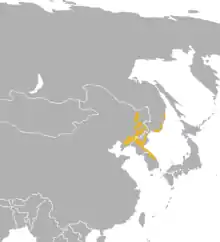 |
Size: 81–129 cm (32–51 in) long[188] Habitat: Forest, shrubland, grassland, and rocky areas[189] Diet: Grass, herbs, shoots, leaves, nuts, as well as fruit[189] |
VU
|
| Red goral
|
N. baileyi Pocock, 1914 |
Eastern Asia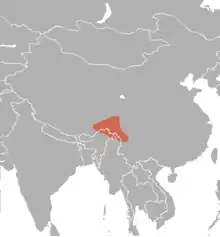 |
Size: 93–103 cm (37–41 in) long, plus 7–10 cm (3–4 in) tail[190] Habitat: Forest, shrubland, and rocky areas[191] Diet: Lichens, as well as grass, shoots, leaves, and twigs[191] |
VU
|
| Common name | Scientific name and subspecies | Range | Size and ecology | IUCN status and estimated population |
|---|---|---|---|---|
| Nilgiri tahr
|
N. hylocrius (Ogilby, 1838) |
Southern India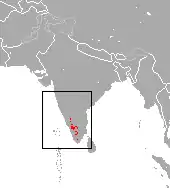 |
Size: 90–140 cm (35–55 in) long, plus 9–12 cm (4–5 in) tail[192] Habitat: Shrubland, grassland, and rocky areas[193] Diet: Grass and forbs[193] |
EN
|
| Common name | Scientific name and subspecies | Range | Size and ecology | IUCN status and estimated population |
|---|---|---|---|---|
| Mountain goat
|
O. americanus (Blainville, 1816) |
Western North America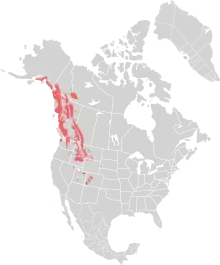 |
Size: 120–160 cm (47–63 in) long, plus 8–20 cm (3–8 in) tail[5] Habitat: Forest, shrubland, grassland, and rocky areas[194] Diet: Grass, forbs, sedges, ferns, moss, lichen, twigs, and leaves[194] |
LC
|
| Common name | Scientific name and subspecies | Range | Size and ecology | IUCN status and estimated population |
|---|---|---|---|---|
| Muskox
|
O. moschatus (Zimmermann, 1780) |
The Arctic (reintroduced in blue) |
Size: 190–270 cm (75–106 in) long, plus 7–12 cm (3–5 in) tail[5] Habitat: Grassland[195] Diet: Sedges and grass, as well as shrubs and some forbs[195] |
LC
|
| Common name | Scientific name and subspecies | Range | Size and ecology | IUCN status and estimated population |
|---|---|---|---|---|
| Argali
|
O. ammon Linnaeus, 1758 Nine subspecies
|
Central and eastern Asia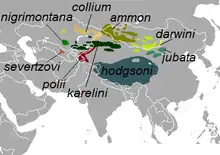 |
Size: 120–190 cm (47–75 in) long[196] Habitat: Forest, shrubland, grassland, rocky areas, and desert[197] Diet: Grass, sedges, and some herbs and lichens[197] |
NT
|
| Bighorn sheep
|
O. canadensis Shaw, 1804 Three subspecies
|
Western North America |
Size: 160–180 cm (63–71 in) long[198] Habitat: Grassland, and rocky areas[199] Diet: Grass, as well as forbs and shrubs[199] |
LC
|
| Dall sheep
|
O. dalli Nelson, 1884 Two subspecies
|
Northwestern North America |
Size: 130–180 cm (51–71 in) long, plus 7–12 cm (3–5 in) tail[200] Habitat: Shrubland, grassland, and rocky areas[201] Diet: Grass and sedges[201] |
LC
|
| Mouflon
|
O. gmelini Blyth, 1841 Four subspecies
|
Western Asia | Size: 105–140 cm (41–55 in) long, plus 12–13 cm (5–5 in) tail[202] Habitat: Forest, shrubland, grassland, and rocky areas[203] Diet: Grass and shrubs[202] |
NT
|
| Sheep
|
O. aries Linnaeus, 1758 |
Domesticated worldwide | Size: 120–180 cm (47–71 in) long, plus 7–15 cm (3–6 in) tail[204] Habitat: Savanna, grassland, desert, forest, and rocky areas[204] Diet: Grass, as well as a wide variety of vegetation[204] |
NE
|
| Snow sheep
|
O. nivicola Eschscholtz, 1829 Six subspecies
|
Eastern Russia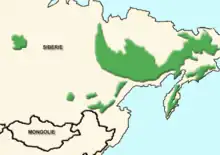 |
Size: 126–188 cm (50–74 in) long[206] Habitat: Forest, shrubland, grassland, and rocky areas[207] Diet: Grass, as well as lichens, mosses, and willow sprouts[207] |
LC
|
| Urial
|
O. vignei Blyth, 1841 |
Central and southern Asia | Size: 120–160 cm (47–63 in) long, plus 11–13 cm (4–5 in) tail[208] Habitat: Forest, shrubland, grassland, and rocky areas[209] Diet: Grass and shrubs[208] |
VU
|
| Common name | Scientific name and subspecies | Range | Size and ecology | IUCN status and estimated population |
|---|---|---|---|---|
| Tibetan antelope
|
P. hodgsonii (Abel, 1826) |
Tibetan Plateau |
Size: 120–130 cm (47–51 in) long[210] Habitat: Grassland[211] Diet: Grass and herbs[210] |
NT
|
| Common name | Scientific name and subspecies | Range | Size and ecology | IUCN status and estimated population |
|---|---|---|---|---|
| Bharal
|
P. nayaur (Hodgson, 1833) |
Himalayas.png.webp) |
Size: 120–140 cm (47–55 in) long[212] Habitat: Forest, shrubland, grassland, rocky areas, and desert[213] Diet: Grass, alpine herbs, and lichens[213] |
LC
|
| Common name | Scientific name and subspecies | Range | Size and ecology | IUCN status and estimated population |
|---|---|---|---|---|
| Chamois
|
R. rupicapra (Linnaeus, 1758) Seven subspecies
|
Europe and western Asia (former range in gray) |
Size: 110–135 cm (43–53 in) long[214] Habitat: Forest, shrubland, grassland, and rocky areas[215] Diet: Grass, herbs, tree leaves, buds, shoots, and fungi[215] |
LC
|
| Pyrenean chamois
|
R. pyrenaica Bonaparte, 1845 Three subspecies
|
Southern Europe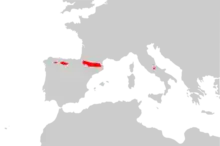 |
Size: 90–130 cm (35–51 in) long, plus 3–4 cm (1–2 in) tail[216] Habitat: Forest, shrubland, grassland, and rocky areas[217] Diet: Herbs and flowers, as well as lichen, moss, and young pine shoots[216] |
LC
|
Subfamily Cephalophinae
| Common name | Scientific name and subspecies | Range | Size and ecology | IUCN status and estimated population |
|---|---|---|---|---|
| Abbott's duiker
|
C. spadix True, 1890 |
Tanzania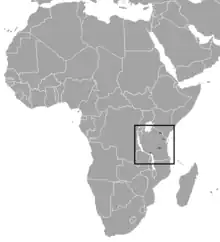 |
Size: 97–140 cm (38–55 in) long, plus 8–13 cm (3–5 in) tail[218] Habitat: Forest and shrubland[219] Diet: Leaves, fruit, flowers and moss[218] |
EN
|
| Aders's duiker
|
C. adersi (Thomas, 1918) |
Eastern Africa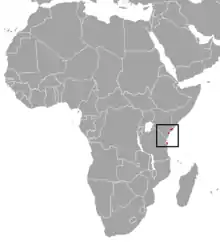 |
Size: 66–72 cm (26–28 in) long, plus 9–12 cm (4–5 in) tail[220] Habitat: Forest and shrubland[221] Diet: Leaves, seeds, sprouts, buds, and fruit[221] |
VU
|
| Bay duiker
|
C. dorsalis Gray, 1846 Two subspecies
|
Western and southern Africa | Size: 70–100 cm (28–39 in) long[222] Habitat: Forest[223] Diet: Fruit and leaves, as well as birds[222] |
NT
|
| Black duiker
|
C. niger (Gray, 1846) |
Western Africa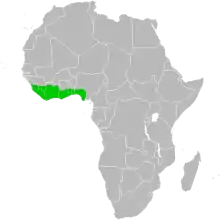 |
Size: 80–90 cm (31–35 in) long, plus 12–14 cm (5–6 in) tail[224] Habitat: Forest[225] Diet: Flowers, leaves, shrubs, grass, fruit, insects, and eggs[225] |
LC
|
| Black-fronted duiker
|
C. nigrifrons (Gray, 1871) Six subspecies
|
Central Africa |
Size: 80–170 cm (31–67 in) long, plus 7–15 cm (3–6 in) tail[226] Habitat: Forest and shrubland[227] Diet: Fruit and leaves[228] |
LC
|
| Brooke's duiker | C. brookei (Thomas, 1903) |
Western Africa | Size: About 100 cm (39 in) long, plus 12 cm (5 in) tail[229] Habitat: Forest[229] Diet: Fruit and leaves[229] |
NE
|
| Jentink's duiker
|
C. jentinki Thomas, 1892 |
Western Africa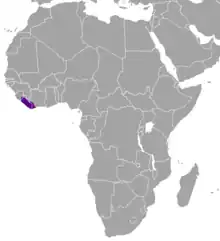 |
Size: 130–150 cm (51–59 in) long, plus 12–16 cm (5–6 in) tail[230] Habitat: Forest[231] Diet: Fruit, nuts, and tree stems[231] |
EN
|
| Ogilby's duiker
|
C. ogilbyi (Waterhouse, 1838) |
Western Africa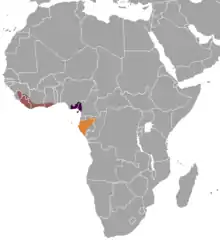 |
Size: 85–115 cm (33–45 in) long, plus 12–15 cm (5–6 in) tail[232] Habitat: Forest[233] Diet: Fruit and leaves[232] |
LC
|
| Peters's duiker
|
C. callipygus (Peters, 1876) |
Western central Africa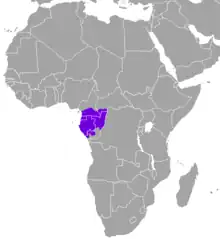 |
Size: 94–109 cm (37–43 in) long, plus 8–15 cm (3–6 in) tail[234] Habitat: Forest[235] Diet: Fruit and leaves[234] |
LC
|
| Red forest duiker
|
C. natalensis (Smith, 1834) Two subspecies
|
Southeastern Africa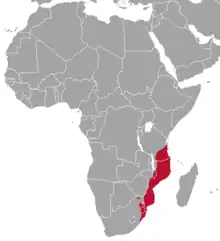 |
Size: 75–87 cm (30–34 in) long, plus 9–14 cm (4–6 in) tail[236] Habitat: Forest and shrubland[237] Diet: Fruit and leaves[236] |
LC
|
| Red-flanked duiker
|
C. rufilatus (Gray, 1846) |
Western and central Africa |
Size: 60–80 cm (24–31 in) long[238] Habitat: Forest and savanna[239] Diet: Leaves and fruit, as well as flowers and twigs[238] |
LC
|
| Weyns's duiker
|
C. weynsi (Thomas, 1901) Three subspecies
|
Central Africa |
Size: 80–115 cm (31–45 in) long, plus 8–16 cm (3–6 in) tail[240] Habitat: Forest[241] Diet: Fruit and leaves[240] |
LC
|
| White-bellied duiker
|
C. leucogaster (Gray, 1873) Two subspecies
|
Central Africa | Size: 78–100 cm (31–39 in) long, plus 8–15 cm (3–6 in) tail[242] Habitat: Forest[243] Diet: Fruit, leaves, and flowers[242] |
NT
|
| White-legged duiker
|
C. crusalbum Grubb, 1978 |
Western Africa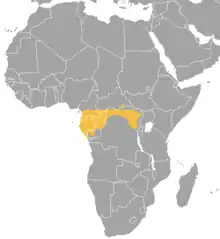 |
Size: 85–115 cm (33–45 in) long, plus 12–15 cm (5–6 in) tail[232] Habitat: Forest[244] Diet: Fruit and leaves[232] |
NT
|
| Yellow-backed duiker
|
C. silvicultor (Afzelius, 1815) Four subspecies
|
Central and western Africa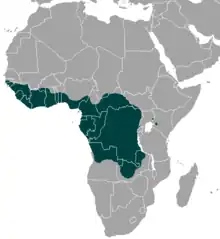 |
Size: 115–145 cm (45–57 in) long, plus 11–18 cm (4–7 in) tail[245] Habitat: Forest, savanna, and shrubland[246] Diet: Fruit, as well as leaves, seeds, buds, bark, and shoots[245] |
NT
|
| Zebra duiker
|
C. zebra (Gray, 1838) |
Western Africa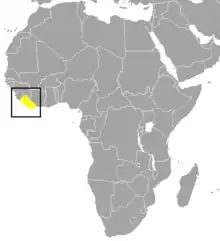 |
Size: 70–90 cm (28–35 in) long, plus 10–15 cm (4–6 in) tail[247] Habitat: Forest[248] Diet: Fruit and leaves[247] |
VU
|
| Common name | Scientific name and subspecies | Range | Size and ecology | IUCN status and estimated population |
|---|---|---|---|---|
| Blue duiker
|
P. monticola (Thunberg, 1789) Twelve subspecies
|
Central and southern Africa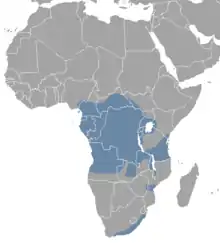 |
Size: 55–72 cm (22–28 in) long, plus 7–13 cm (3–5 in) tail[249] Habitat: Forest[250] Diet: Fruit, seeds, flowers, and fungi[249] |
LC
|
| Maxwell's duiker
|
P. maxwellii (H. Smith, 1827) Two subspecies
|
Western Africa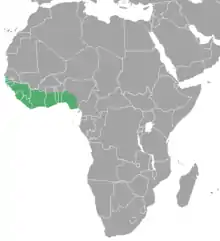 |
Size: 36–40 cm (14–16 in) long[251] Habitat: Forest and shrubland[252] Diet: Leaves and fruit[252] |
LC
|
| Walter's duiker
|
P. walteri Colyn, Huselman, Sonet, Oudé, Winters, Natta, Nagy, Verheyen, 2010 |
Western Africa | Size: Similar to Maxwell's duiker[251] Habitat: Shrubland[253] Diet: Leaves and fruit[251] |
DD
|
| Common name | Scientific name and subspecies | Range | Size and ecology | IUCN status and estimated population |
|---|---|---|---|---|
| Common duiker
|
S. grimmia (Linnaeus, 1758) Thirteen subspecies
|
Sub-Saharan Africa | Size: 70–105 cm (28–41 in) long, plus 10–20 cm (4–8 in) tail[254] Habitat: Forest, savanna, shrubland, grassland, and desert[255] Diet: Variety of foliage, herbs, fruit, seeds, and cultivated crops[255] |
LC
|
Subfamily Hippotraginae
| Common name | Scientific name and subspecies | Range | Size and ecology | IUCN status and estimated population |
|---|---|---|---|---|
| Addax
|
A. nasomaculatus (Blainville, 1816) |
Scattered western Africa.png.webp) |
Size: 150–170 cm (59–67 in) long, plus 25–35 cm (10–14 in) tail[256] Habitat: Savanna, grassland, and desert[257] Diet: Grass and shrubs[256] |
CR
|
| Common name | Scientific name and subspecies | Range | Size and ecology | IUCN status and estimated population |
|---|---|---|---|---|
| Bluebuck†
|
H. leucophaeus (Pallas, 1766) |
Southern tip of Africa (former range) |
Size: 230–300 cm (91–118 in) long[258] Habitat: Grassland[259] Diet: Grass[258] |
EX
|
| Roan antelope
|
H. equinus (Desmarest, 1804) Six subspecies
|
Sub-Saharan Africa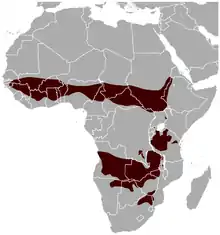 |
Size: 190–240 cm (75–94 in) long, plus 37–48 cm (15–19 in) tail[260] Habitat: Forest, savanna, shrubland, and grassland[261] Diet: Grass[260] |
LC
|
| Sable antelope
|
H. niger (Harris, 1838) Four subspecies
|
Southeastern Africa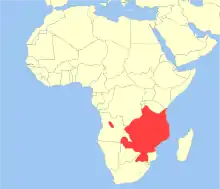 |
Size: 190–255 cm (75–100 in) long, plus 40–75 cm (16–30 in) tail[262] Habitat: Forest, savanna, shrubland, and grassland[263] Diet: Grass, as well as forbs and leaves[263] |
LC
|
| Common name | Scientific name and subspecies | Range | Size and ecology | IUCN status and estimated population |
|---|---|---|---|---|
| Arabian oryx
|
O. leucoryx (Pallas, 1777) |
Arabian Peninsula |
Size: 153–235 cm (60–93 in) long, plus 45–90 cm (18–35 in) tail[264] Habitat: Desert[265] Diet: Grass and shrubs[265] |
VU
|
| East African oryx
|
O. beisa (Rüppell, 1835) Two subspecies
|
Eastern Africa |
Size: 153–170 cm (60–67 in) long, plus 45–50 cm (18–20 in) tail[266] Habitat: Savanna, shrubland, grassland, and desert[267] Diet: Grass and shrubs, as well as melons, roots, bulbs, and tubers[267] |
EN
|
| Gemsbok
|
O. gazella (Linnaeus, 1758) |
Southern Africa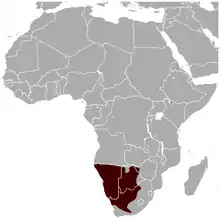 |
Size: 180–195 cm (71–77 in) long[268] Habitat: Savanna, shrubland, grassland, and desert[269] Diet: Grass and shrubs, as well as melons, roots, bulbs, and tubers[269] |
LC
|
| Scimitar oryx
|
O. dammah (Cretzschmar, 1827) |
Reservation in Chad | Size: 190–220 cm (75–87 in) long, plus 45–60 cm (18–24 in) tail[270] Habitat: Savanna, shrubland, and desert[271] Diet: Grass, herbs, roots, and buds, as well as fruit and vegetables[272] |
EN
|
Subfamily Nesotraginae
| Common name | Scientific name and subspecies | Range | Size and ecology | IUCN status and estimated population |
|---|---|---|---|---|
| Bates's pygmy antelope
|
N. batesi (Winton, 1903) |
Central Africa |
Size: 50–58 cm (20–23 in) long, plus 4–5 cm (2–2 in) tail[273] Habitat: Forest[274] Diet: Leaves[274] |
LC
|
| Suni
|
N. moschatus von Dueben, 1846 Four subspecies
|
Eastern Africa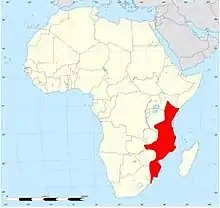 |
Size: 57–62 cm (22–24 in) long[275] Habitat: Forest and shrubland[276] Diet: Leaves[275] |
LC
|
Subfamily Reduncinae
| Common name | Scientific name and subspecies | Range | Size and ecology | IUCN status and estimated population |
|---|---|---|---|---|
| Kob
|
K. kob (Erxleben, 1777) Three subspecies
|
Central and western Africa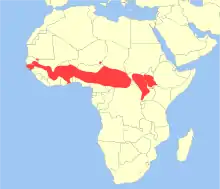 |
Size: 160–180 cm (63–71 in) long, plus 10–15 cm (4–6 in) tail[277] Habitat: Savanna, shrubland, grassland, and inland wetlands[278] Diet: Grass[278] |
LC
|
| Lechwe
|
K. leche Gray, 1850 Four subspecies
|
Scattered southern Africa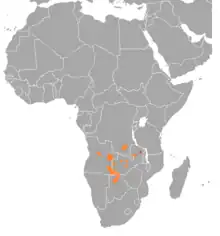 |
Size: 130–180 cm (51–71 in) long, plus 30–45 cm (12–18 in) tail[279] Habitat: Forest, grassland, and inland wetlands[280] Diet: Floodplain and aquatic grass[280] |
NT
|
| Nile lechwe
|
K. megaceros (Fitzinger, 1855) |
South Sudan and Ethiopia | Size: 130–180 cm (51–71 in) long, plus 45–50 cm (18–20 in) tail[281] Habitat: Grassland and inland wetlands[282] Diet: Grass and water plants[283] |
EN
|
| Puku
|
K. vardonii (Livingstone, 1857) Two subspecies
|
Scattered south-central Africa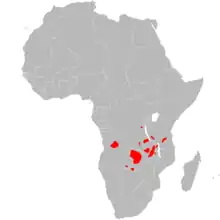 |
Size: 126–142 cm (50–56 in) long[284] Habitat: Savanna, grassland, and inland wetlands[285] Diet: Grass[284] |
NT
|
| Waterbuck
|
K. ellipsiprymnus (Ogilby, 1833) Thirteen subspecies
|
Sub-Saharan Africa (ellipsiprymnus, kondensis, pallidus, and thikae in yellow) |
Size: 177–235 cm (70–93 in) long[286] Habitat: Forest, savanna, shrubland, and grassland[287] Diet: Grass and shrubs[287] |
LC
|
| Common name | Scientific name and subspecies | Range | Size and ecology | IUCN status and estimated population |
|---|---|---|---|---|
| Grey rhebok
|
P. capreolus (Forster, 1790) |
Southern Africa | Size: 115–125 cm (45–49 in) long[288] Habitat: Savanna and grassland[289] Diet: Shrubs and forbs[289] |
NT
|
| Common name | Scientific name and subspecies | Range | Size and ecology | IUCN status and estimated population |
|---|---|---|---|---|
| Bohor reedbuck
|
R. redunca (Pallas, 1767) Seven subspecies
|
Central Africa | Size: 100–135 cm (39–53 in) long[290] Habitat: Savanna, shrubland, and grassland[291] Diet: Grass[291] |
LC
|
| Mountain reedbuck
|
R. fulvorufula (Afzelius, 1815) Three subspecies
|
Separated central, eastern, and southern Africa |
Size: 100–124 cm (39–49 in) long, plus 13–20 cm (5–8 in) tail[292] Habitat: Shrubland, grassland, and rocky areas[293] Diet: Grass[293] |
EN
|
| Southern reedbuck
|
R. arundinum (Boddaert, 1785) |
Southern Africa |
Size: 134–167 cm (53–66 in) long[294] Habitat: Savanna, shrubland, grassland, and inland wetlands[295] Diet: Grass, as well as herbs and shrubs[295] |
LC
|
Notes
References
- 1 2 Castelló, p. 624
- 1 2 IUCN SSC Antelope Specialist Group (2008). "Eudorcas rufina". IUCN Red List of Threatened Species. 2008: e.T8974A12944313. doi:10.2305/IUCN.UK.2008.RLTS.T8974A12944313.en.
- 1 2 3 4 Timmins, R. J.; Burton, J.; Hedges, S. (2016). "Bos sauveli". IUCN Red List of Threatened Species. 2016: e.T2890A46363360. doi:10.2305/IUCN.UK.2016-2.RLTS.T2890A46363360.en.
- ↑ "Fossilworks: Bovidae". Paleobiology Database. University of Wisconsin–Madison. Retrieved December 17, 2021.
- 1 2 3 4 5 6 7 8 9 Harris, pp. 122–131
- 1 2 3 IUCN SSC Antelope Specialist Group (2016). "Aepyceros melampus". IUCN Red List of Threatened Species. 2016: e.T550A50180828. doi:10.2305/IUCN.UK.2016-2.RLTS.T550A50180828.en.
- ↑ Lundrigan, Barbara; Sproull, Karen (2000). "Aepyceros melampus". Animal Diversity Web. University of Michigan. Archived from the original on April 26, 2021. Retrieved April 30, 2021.
- ↑ Batty, Kristin (2002). "Alcelaphus buselaphus". Animal Diversity Web. University of Michigan. Archived from the original on May 13, 2021. Retrieved May 27, 2021.
- 1 2 3 IUCN SSC Antelope Specialist Group (2019) [amended version of 2016 assessment]. "Alcelaphus buselaphus". IUCN Red List of Threatened Species. 2019: e.T811A143160967. doi:10.2305/IUCN.UK.2019-1.RLTS.T811A143160967.en.
- 1 2 Olney, Hannah (2002). "Beatragus hunteri". Animal Diversity Web. University of Michigan. Archived from the original on September 8, 2021. Retrieved March 27, 2021.
- 1 2 3 IUCN SSC Antelope Specialist Group (2017). "Beatragus hunteri". IUCN Red List of Threatened Species. 2017: e.T6234A50185297. doi:10.2305/IUCN.UK.2017-2.RLTS.T6234A50185297.en.
- ↑ "Black wildebeest (Connochaetes gnou)". ARKive. Wildscreen. Archived from the original on February 1, 2019. Retrieved September 5, 2021.
- 1 2 3 Vrahimis, S.; Grobler, P.; Brink, J.; Viljoen, P.; Schulze, E. (2017). "Connochaetes gnou". IUCN Red List of Threatened Species. 2017: e.T5228A50184962. doi:10.2305/IUCN.UK.2017-2.RLTS.T5228A50184962.en.
- 1 2 3 IUCN SSC Antelope Specialist Group (2020) [errata version of 2016 assessment]. "Connochaetes taurinus". IUCN Red List of Threatened Species. 2016: e.T5229A163322525. doi:10.2305/IUCN.UK.2016-2.RLTS.T5229A163322525.en.
- ↑ Csomos, Rebecca Ann (2001). "Damaliscus pygargus". Animal Diversity Web. University of Michigan. Archived from the original on February 3, 2021. Retrieved March 27, 2021.
- 1 2 3 Dalton, D.; Birss, C.; Cowell, C.; Gaylard, A.; Kotze, A.; Parrini, F.; Peinke, D.; Radloff, F.; Viljoen, P. (2019). "Damaliscus pygargus". IUCN Red List of Threatened Species. 2019: e.T30208A50197331. doi:10.2305/IUCN.UK.2019-1.RLTS.T30208A50197331.en.
- ↑ Kingdon 2013, ch. Topi, Tiang, Tsessebe
- 1 2 3 IUCN SSC Antelope Specialist Group (2016). "Damaliscus lunatus". IUCN Red List of Threatened Species. 2016: e.T6235A50185422. doi:10.2305/IUCN.UK.2016-2.RLTS.T6235A50185422.en.
- 1 2 Derrig, Jim Bob (2003). "Ammodorcas clarkei". Animal Diversity Web. University of Michigan. Archived from the original on August 23, 2020. Retrieved March 27, 2021.
- 1 2 3 Heckel, J.; Wilhelmi, F.; Kaariye, X.; Amir, O. (2016). "Ammodorcas clarkei". IUCN Red List of Threatened Species. 2016: e.T1141A50181613. doi:10.2305/IUCN.UK.2016-2.RLTS.T1141A50181613.en.
- ↑ Kingdon 2013, ch. Springbok
- 1 2 3 IUCN SSC Antelope Specialist Group (2017) [errata version of 2016 assessment]. "Antidorcas marsupialis". IUCN Red List of Threatened Species. 2016: e.T1676A50181753. doi:10.2305/IUCN.UK.2016-3.RLTS.T1676A50181753.en.
- ↑ "Blackbuck (Antilope cervicapra)". ARKive. Wildscreen. Archived from the original on February 1, 2019. Retrieved September 5, 2021.
- 1 2 3 IUCN SSC Antelope Specialist Group (2017). "Antilope cervicapra". IUCN Red List of Threatened Species. 2017: e.T1681A50181949. doi:10.2305/IUCN.UK.2017-2.RLTS.T1681A50181949.en.
- ↑ Kingdon 2020, ch. Beira
- 1 2 3 IUCN SSC Antelope Specialist Group (2016). "Dorcatragus megalotis". IUCN Red List of Threatened Species. 2016: e.T6793A50185898. doi:10.2305/IUCN.UK.2016-1.RLTS.T6793A50185898.en.
- 1 2 Castelló, p. 112
- 1 2 IUCN SSC Antelope Specialist Group (2017). "Eudorcas tilonura". IUCN Red List of Threatened Species. 2017: e.T8991A50188182. doi:10.2305/IUCN.UK.2017-2.RLTS.T8991A50188182.en.
- 1 2 Castelló, p. 108
- 1 2 IUCN SSC Antelope Specialist Group (2016). "Eudorcas albonotata". IUCN Red List of Threatened Species. 2016: e.T8992A50188208. doi:10.2305/IUCN.UK.2016-2.RLTS.T8992A50188208.en.
- 1 2 Kingdon 2020, ch. Red-fronted gazelle
- 1 2 IUCN SSC Antelope Specialist Group (2017). "Eudorcas rufifrons". IUCN Red List of Threatened Species. 2017: e.T8973A50187042. doi:10.2305/IUCN.UK.2017-2.RLTS.T8973A50187042.en.
- ↑ Auman, Amy; Fye, Rachael; Dewey, Tanya (2009). "Eudorcas thomsonii". Animal Diversity Web. University of Michigan. Archived from the original on February 4, 2019. Retrieved March 27, 2021.
- 1 2 3 IUCN SSC Antelope Specialist Group (2020) [errata version of 2018 assessment]. "Eudorcas thomsonii". IUCN Red List of Threatened Species. 2018: e.T8982A172360006. doi:10.2305/IUCN.UK.2018-2.RLTS.T8982A172360006.en.
- ↑ Castelló, p. 132
- 1 2 3 IUCN SSC Antelope Specialist Group (2017). "Gazella arabica". IUCN Red List of Threatened Species. 2017: e.T117582065A88018124. doi:10.2305/IUCN.UK.2017-2.RLTS.T117582065A88018124.en.
- 1 2 Castelló, p. 156
- 1 2 IUCN SSC Antelope Specialist Group (2017). "Gazella marica". IUCN Red List of Threatened Species. 2017: e.T8977A50187738. doi:10.2305/IUCN.UK.2017-2.RLTS.T8977A50187738.en.
- 1 2 McCart, Dylan (2012). "Gazella bennettii". Animal Diversity Web. University of Michigan. Archived from the original on May 12, 2021. Retrieved May 11, 2021.
- 1 2 IUCN SSC Antelope Specialist Group (2017). "Gazella bennettii". IUCN Red List of Threatened Species. 2017: e.T8978A50187762. doi:10.2305/IUCN.UK.2017-2.RLTS.T8978A50187762.en.
- 1 2 Kingdon 2020, ch. Cuvier's gazelle
- 1 2 IUCN SSC Antelope Specialist Group (2016). "Gazella cuvieri". IUCN Red List of Threatened Species. 2016: e.T8967A50186003. doi:10.2305/IUCN.UK.2016-2.RLTS.T8967A50186003.en.
- ↑ Kingdon 2020, ch. Dorcas gazelle
- 1 2 IUCN SSC Antelope Specialist Group (2017). "Gazella dorcas". IUCN Red List of Threatened Species. 2017: e.T8969A50186334. doi:10.2305/IUCN.UK.2017-2.RLTS.T8969A50186334.en.
- ↑ Stoolman, Joshua (2006). "Gazella dorcas". Animal Diversity Web. University of Michigan. Archived from the original on September 7, 2021. Retrieved September 6, 2021.
- 1 2 3 Castelló, p. 134
- ↑ Castelló, p. 150
- 1 2 IUCN SSC Antelope Specialist Group (2017). "Gazella subgutturosa". IUCN Red List of Threatened Species. 2017: e.T8976A50187422. doi:10.2305/IUCN.UK.2017-2.RLTS.T8976A50187422.en.
- ↑ Cichon, Catherine; Woo, Yangshin; Woo, Krystal (2011). "Gazella subgutturosa". Animal Diversity Web. University of Michigan. Archived from the original on May 25, 2021. Retrieved September 7, 2021.
- ↑ Castelló, p. 128
- 1 2 IUCN SSC Antelope Specialist Group (2017). "Gazella gazella". IUCN Red List of Threatened Species. 2017: e.T8989A50186574. doi:10.2305/IUCN.UK.2017-2.RLTS.T8989A50186574.en.
- ↑ Lee, Kari (2003). "Gazella gazella". Animal Diversity Web. University of Michigan. Archived from the original on September 7, 2021. Retrieved September 6, 2021.
- ↑ Castelló, p. 146
- 1 2 3 IUCN SSC Antelope Specialist Group (2016). "Gazella leptoceros". IUCN Red List of Threatened Species. 2016: e.T8972A50186909. doi:10.2305/IUCN.UK.2016-2.RLTS.T8972A50186909.en.
- 1 2 Kingdon 2013, ch. Speke's gazelle
- 1 2 IUCN SSC Antelope Specialist Group (2016). "Gazella spekei". IUCN Red List of Threatened Species. 2016: e.T8975A50187314. doi:10.2305/IUCN.UK.2016-2.RLTS.T8975A50187314.en.
- ↑ Payne, Jamie (2003). "Litocranius walleri". Animal Diversity Web. University of Michigan. Archived from the original on May 21, 2021. Retrieved May 21, 2021.
- 1 2 3 IUCN SSC Antelope Specialist Group (2016). "Litocranius walleri". IUCN Red List of Threatened Species. 2016: e.T12142A50190292. doi:10.2305/IUCN.UK.2016-2.RLTS.T12142A50190292.en.
- ↑ Kingdon 2020, ch. Günther's dik-dik
- 1 2 IUCN SSC Antelope Specialist Group (2016). "Madoqua guentheri". IUCN Red List of Threatened Species. 2016: e.T12669A50190613. doi:10.2305/IUCN.UK.2016-1.RLTS.T12669A50190613.en.
- ↑ Jacques, Kristi (2000). "Madoqua guentheri". Animal Diversity Web. University of Michigan. Archived from the original on April 22, 2021. Retrieved September 6, 2021.
- ↑ Scheibe, Elizabeth (1999). "Madoqua kirkii". Animal Diversity Web. University of Michigan. Archived from the original on April 28, 2021. Retrieved May 21, 2021.
- 1 2 3 IUCN SSC Antelope Specialist Group (2016). "Madoqua kirkii". IUCN Red List of Threatened Species. 2016: e.T12670A50190709. doi:10.2305/IUCN.UK.2016-1.RLTS.T12670A50190709.en.
- 1 2 Lundrigan, Barbara; Kapheim, Karen (2000). "Madoqua saltiana". Animal Diversity Web. University of Michigan. Archived from the original on April 22, 2021. Retrieved May 21, 2021.
- 1 2 3 IUCN SSC Antelope Specialist Group (2016). "Madoqua saltiana". IUCN Red List of Threatened Species. 2016: e.T12668A50190537. doi:10.2305/IUCN.UK.2016-1.RLTS.T12668A50190537.en.
- 1 2 Castelló, p. 214
- 1 2 IUCN SSC Antelope Specialist Group (2016). "Madoqua piacentinii". IUCN Red List of Threatened Species. 2016: e.T12667A50190430. doi:10.2305/IUCN.UK.2016-1.RLTS.T12667A50190430.en.
- ↑ Villarreal, Lisa (2006). "Nanger dama". Animal Diversity Web. University of Michigan. Archived from the original on May 19, 2021. Retrieved May 21, 2021.
- 1 2 3 IUCN SSC Antelope Specialist Group (2016). "Nanger dama". IUCN Red List of Threatened Species. 2016: e.T8968A50186128. doi:10.2305/IUCN.UK.2016-2.RLTS.T8968A50186128.en.
- ↑ Kingdon 2013, ch. Grant's gazelle
- 1 2 3 IUCN SSC Antelope Specialist Group (2016). "Nanger granti". IUCN Red List of Threatened Species. 2016: e.T8971A50186774. doi:10.2305/IUCN.UK.2016-2.RLTS.T8971A50186774.en.
- ↑ Khankari, Nikhil (2006). "Nanger granti". Animal Diversity Web. University of Michigan. Archived from the original on May 21, 2021. Retrieved May 21, 2021.
- 1 2 Kingdon 2013, ch. Soemmerring's gazelle
- 1 2 IUCN SSC Antelope Specialist Group (2016). "Nanger soemmerringii". IUCN Red List of Threatened Species. 2016: e.T63541A50197739. doi:10.2305/IUCN.UK.2016-2.RLTS.T63541A50197739.en.
- 1 2 Kingdon 2020, ch. Royal antelope
- 1 2 IUCN SSC Antelope Specialist Group (2016). "Neotragus pygmaeus". IUCN Red List of Threatened Species. 2016: e.T14602A50190835. doi:10.2305/IUCN.UK.2016-1.RLTS.T14602A50190835.en.
- ↑ Ewacha, Michelle (2013). "Oreotragus oreotragus". Animal Diversity Web. University of Michigan. Archived from the original on May 24, 2021. Retrieved May 24, 2021.
- 1 2 3 IUCN SSC Antelope Specialist Group (2016). "Oreotragus oreotragus". IUCN Red List of Threatened Species. 2016: e.T15485A50191264. doi:10.2305/IUCN.UK.2016-1.RLTS.T15485A50191264.en.
- 1 2 Frey, Dayna (2000). "Ourebia ourebi". Animal Diversity Web. University of Michigan. Archived from the original on April 20, 2021. Retrieved June 18, 2021.
- 1 2 IUCN SSC Antelope Specialist Group (2016). "Ourebia ourebi". IUCN Red List of Threatened Species. 2016: e.T15730A50192202. doi:10.2305/IUCN.UK.2016-1.RLTS.T15730A50192202.en.
- 1 2 Castelló, p. 164
- 1 2 IUCN SSC Antelope Specialist Group (2017) [errata version of 2016 assessment]. "Procapra picticaudata". IUCN Red List of Threatened Species. 2016: e.T18231A50192968. doi:10.2305/IUCN.UK.2016-3.RLTS.T18231A50192968.en.
- 1 2 Wick, Jill (2004). "Procapra gutturosa". Animal Diversity Web. University of Michigan. Archived from the original on May 27, 2021. Retrieved June 18, 2021.
- 1 2 IUCN SSC Antelope Specialist Group (2017) [errata version of 2016 assessment]. "Procapra gutturosa". IUCN Red List of Threatened Species. 2016: e.T18232A50193126. doi:10.2305/IUCN.UK.2016-3.RLTS.T18232A50193126.en.
- 1 2 Li, Binbin (2011). "Procapra przewalskii". Animal Diversity Web. University of Michigan. Archived from the original on May 25, 2021. Retrieved June 18, 2021.
- 1 2 IUCN SSC Antelope Specialist Group (2016). "Procapra przewalskii". IUCN Red List of Threatened Species. 2016: e.T18230A50192807. doi:10.2305/IUCN.UK.2016-3.RLTS.T18230A50192807.en.
- ↑ Kingdon 2020, ch. Cape grysbok
- 1 2 3 Palmer, G.; Birss, C.; Kerley, G.; Feely, J.; Peinke, D.; Castley, G. (2017). "Raphicerus melanotis". IUCN Red List of Threatened Species. 2017: e.T19306A50193334. doi:10.2305/IUCN.UK.2017-2.RLTS.T19306A50193334.en.
- ↑ Hocking, Scott (2004). "Raphicerus sharpei". Animal Diversity Web. University of Michigan. Archived from the original on September 2, 2021. Retrieved March 27, 2021.
- 1 2 3 IUCN SSC Antelope Specialist Group (2016). "Raphicerus sharpei". IUCN Red List of Threatened Species. 2016: e.T19307A50193414. doi:10.2305/IUCN.UK.2016-1.RLTS.T19307A50193414.en.
- ↑ Newell, Toni Lynn (1999). "Raphicerus campestris". Animal Diversity Web. University of Michigan. Archived from the original on June 24, 2021. Retrieved June 18, 2021.
- 1 2 3 IUCN SSC Antelope Specialist Group (2016). "Raphicerus campestris". IUCN Red List of Threatened Species. 2016: e.T19308A50193533. doi:10.2305/IUCN.UK.2016-1.RLTS.T19308A50193533.en.
- ↑ Castelló, p. 170
- 1 2 3 IUCN SSC Antelope Specialist Group (2023). "Saiga tatarica". IUCN Red List of Threatened Species. 2023: e.T19832A233712210. doi:10.2305/IUCN.UK.2023-1.RLTS.T19832A233712210.en.
- 1 2 3 Aune, K.; Jørgensen, D.; Gates, C. (2018) [errata version of 2017 assessment]. "Bison bison". IUCN Red List of Threatened Species. 2017: e.T2815A45156541. doi:10.2305/IUCN.UK.2017-3.RLTS.T2815A45156541.en.
- ↑ "Bison". Minnesota Department of Natural Resources. Archived from the original on August 19, 2021. Retrieved October 14, 2021.
- ↑ Semenov, U. A. (2014). "The Wisents of Karachay-Cherkessia". Proceedings of the Sochi National Park. KMK Scientific Press. pp. 23–24. ISBN 978-5-87317-984-8.
- 1 2 Plumb, G.; Kowalczyk, R.; Hernandez-Blanco, J. A. (2020). "Bison bonasus". IUCN Red List of Threatened Species. 2020: e.T2814A45156279. doi:10.2305/IUCN.UK.2020-3.RLTS.T2814A45156279.en.
- ↑ Hendricks, Kassondra (2013). "Bison bonasus". Animal Diversity Web. University of Michigan. Archived from the original on July 20, 2021. Retrieved September 6, 2021.
- 1 2 3 4 5 Dewey, Tanya; Ng, Jessica (2001). "Bos taurus". Animal Diversity Web. University of Michigan. Archived from the original on August 30, 2019. Retrieved September 6, 2021.
- 1 2 Saari, Jason (2002). "Bos javanicus". Animal Diversity Web. University of Michigan. Archived from the original on April 9, 2021. Retrieved March 27, 2021.
- 1 2 3 4 5 Gardner, P.; Hedges, S.; Pudyatmoko, S.; Gray, T. N. E.; Timmins, R. J. (2016). "Bos javanicus". IUCN Red List of Threatened Species. 2016: e.T2888A46362970. doi:10.2305/IUCN.UK.2016-2.RLTS.T2888A46362970.en.
- 1 2 Castelló, p. 642
- ↑ Plumer, Brad (February 5, 2015). "These maps show where all the world's cattle, chickens, and pigs are". Vox. Vox Media. Archived from the original on April 1, 2021. Retrieved April 6, 2021.
- 1 2 3 Duckworth, J. W.; Sankar, K.; Williams, A. C.; Samba Kumar, N.; Timmins, R. J. (2016). "Bos gaurus". IUCN Red List of Threatened Species. 2016: e.T2891A46363646. doi:10.2305/IUCN.UK.2016-2.RLTS.T2891A46363646.en.
- 1 2 3 4 Lundrigan, Barbara; Zachariah, Trevor (2000). "Bos frontalis". Animal Diversity Web. University of Michigan. Archived from the original on June 4, 2021. Retrieved June 19, 2021.
- ↑ Mukherjee, A.; Mukherjee, S.; Dhakal, R.; et al. (2018). "High-density Genotyping reveals Genomic Characterization, Population Structure and Genetic Diversity of Indian Mithun (Bos frontalis)". Scientific Reports. 8 (10316): 10316. Bibcode:2018NatSR...810316M. doi:10.1038/s41598-018-28718-x. PMC 6037757. PMID 29985484.
- ↑ Winker, Jill (2004). "Bos sauveli". Animal Diversity Web. University of Michigan. Archived from the original on June 24, 2021. Retrieved June 19, 2021.
- ↑ Castelló, p. 636
- 1 2 3 Buzzard, P.; Berger, J. (2016). "Bos mutus". IUCN Red List of Threatened Species. 2016: e.T2892A101293528. doi:10.2305/IUCN.UK.2016-2.RLTS.T2892A101293528.en.
- ↑ Castelló, p. 638
- 1 2 Oliphant, Matthew (2003). "Bos grunniens". Animal Diversity Web. University of Michigan. Archived from the original on August 30, 2019. Retrieved September 6, 2021.
- ↑ Wu, Yantao; et al. (2018). "Mitochondrial genome data confirm that yaks can serve as the intermediate host of Echinococcus canadensis (G10) on the Tibetan Plateau". Parasites & Vectors. 11 (166): 166. doi:10.1186/s13071-018-2684-0. PMC 5845295. PMID 29523164.
- ↑ Benton, Melody (2000). "Boselaphus tragocamelus". Animal Diversity Web. University of Michigan. Archived from the original on October 26, 2020. Retrieved July 7, 2021.
- 1 2 3 IUCN SSC Antelope Specialist Group (2017) [errata version of 2016 assessment]. "Boselaphus tragocamelus". IUCN Red List of Threatened Species. 2016: e.T2893A50182076. doi:10.2305/IUCN.UK.2016-3.RLTS.T2893A50182076.en.
- ↑ Castelló, p. 606
- 1 2 3 Burton, J.; Wheeler, P.; Mustari, A. (2016). "Bubalus depressicornis". IUCN Red List of Threatened Species. 2016: e.T3126A46364222. doi:10.2305/IUCN.UK.2016-2.RLTS.T3126A46364222.en.
- ↑ Castelló, p. 607
- 1 2 3 Burton, J.; Wheeler, P.; Mustari, A. (2016). "Bubalus quarlesi". IUCN Red List of Threatened Species. 2016: e.T3128A46364433. doi:10.2305/IUCN.UK.2016-2.RLTS.T3128A46364433.en.
- ↑ Gesch, Peter (2004). "Bubalus mindorensis". Animal Diversity Web. University of Michigan. Archived from the original on August 28, 2021. Retrieved August 18, 2021.
- 1 2 3 Boyles, R.; Schutz, E.; de Leon, J. (2016). "Bubalus mindorensis". IUCN Red List of Threatened Species. 2016: e.T3127A50737640. doi:10.2305/IUCN.UK.2016-2.RLTS.T3127A50737640.en.
- 1 2 3 Roth, Jason (2004). "Bubalus bubalis". Animal Diversity Web. University of Michigan. Archived from the original on February 22, 2021. Retrieved March 27, 2021.
- ↑ Zhang, Y.; Colli, L.; Barker, J. S. F. (2020). "Asian water buffalo: domestication, history and genetics". Animal Genetics. 51 (2): 177–191. doi:10.1111/age.12911. PMID 31967365.
- 1 2 Castelló, p. 596
- 1 2 Kaul, R.; Williams, A. C.; Rithe, K.; Steinmetz, R.; Mishra, R. (2019). "Bubalus arnee". IUCN Red List of Threatened Species. 2019: e.T3129A46364616. doi:10.2305/10.2305/IUCN.UK.2019-1.RLTS.T3129A46364616.en.
- ↑ Castelló, p. 648
- 1 2 3 Timmins, R. J.; Hedges, S.; Robichaud, W. (2020) [amended version of 2016 assessment]. "Pseudoryx nghetinhensis". IUCN Red List of Threatened Species. 2020: e.T18597A166485696. doi:10.2305/IUCN.UK.2020-1.RLTS.T18597A166485696.en.
- 1 2 IUCN SSC Antelope Specialist Group (2019). "Syncerus caffer". IUCN Red List of Threatened Species. 2019: e.T21251A50195031. doi:10.2305/IUCN.UK.2019-1.RLTS.T21251A50195031.en.
- ↑ Kingdon 2013, ch. Common eland
- 1 2 3 IUCN SSC Antelope Specialist Group (2017) [errata version of 2016 assessment]. "Tragelaphus oryx". IUCN Red List of Threatened Species. 2016: e.T22055A50196938. doi:10.2305/IUCN.UK.2016-3.RLTS.T22055A50196938.en.
- ↑ Kingdon 2013, ch. Giant eland
- ↑ Altan, Berke (2000). "Taurotragus derbianus". Animal Diversity Web. University of Michigan. Archived from the original on January 14, 2021. Retrieved March 27, 2021.
- 1 2 3 IUCN SSC Antelope Specialist Group (2017). "Tragelaphus derbianus". IUCN Red List of Threatened Species. 2017: e.T44172A50197518. doi:10.2305/10.2305/IUCN.UK.2017-2.RLTS.T44172A50197518.en.
- ↑ Lundeen, Brooks (2003). "Tetracerus quadricornis". Animal Diversity Web. University of Michigan. Archived from the original on August 18, 2021. Retrieved August 18, 2021.
- 1 2 3 IUCN SSC Antelope Specialist Group (2017). "Tetracerus quadricornis". IUCN Red List of Threatened Species. 2017: e.T21661A50195368. doi:10.2305/IUCN.UK.2017-2.RLTS.T21661A50195368.en.
- ↑ "Bongo (Tragelaphus eurycerus)". ARKive. Wildscreen. Archived from the original on February 1, 2019. Retrieved September 5, 2021.
- 1 2 3 IUCN SSC Antelope Specialist Group (2017) [errata version of 2016 assessment]. "Tragelaphus eurycerus". IUCN Red List of Threatened Species. 2016: e.T22047A50195617. doi:10.2305/IUCN.UK.2016-3.RLTS.T22047A50195617.en.
- 1 2 3 IUCN SSC Antelope Specialist Group (2020) [amended version of 2016 assessment]. "Tragelaphus strepsiceros". IUCN Red List of Threatened Species. 2020: e.T22054A166487759. doi:10.2305/IUCN.UK.2020-1.RLTS.T22054A166487759.en.
- ↑ Kingdon 2020, ch. Bushbuck
- 1 2 3 IUCN SSC Antelope Specialist Group (2017) [errata version of 2016 assessment]. "Tragelaphus scriptus". IUCN Red List of Threatened Species. 2016: e.T22051A50196111. doi:10.2305/IUCN.UK.2016-3.RLTS.T22051A50196111.en.
- ↑ Paschka, Nick (2000). "Tragelaphus imberbis". Animal Diversity Web. University of Michigan. Archived from the original on August 18, 2021. Retrieved August 18, 2021.
- 1 2 3 IUCN SSC Antelope Specialist Group (2017) [errata version of 2016 assessment]. "Tragelaphus imberbis". IUCN Red List of Threatened Species. 2016: e.T22053A50196563. doi:10.2305/IUCN.UK.2016-3.RLTS.T22053A50196563.en.
- 1 2 Aleman, Maria (2003). "Tragelaphus buxtoni". Animal Diversity Web. University of Michigan. Archived from the original on August 25, 2021. Retrieved August 18, 2021.
- 1 2 IUCN SSC Antelope Specialist Group (2017) [errata version of 2016 assessment]. "Tragelaphus buxtoni". IUCN Red List of Threatened Species. 2016: e.T22046A50195483. doi:10.2305/IUCN.UK.2016-3.RLTS.T22046A50195483.en.
- ↑ Kingdon 2013, ch. Nyala
- 1 2 3 IUCN SSC Antelope Specialist Group (2017) [errata version of 2016 assessment]. "Tragelaphus angasii". IUCN Red List of Threatened Species. 2016: e.T22052A50196443. doi:10.2305/IUCN.UK.2016-3.RLTS.T22052A50196443.en.
- ↑ Kingdon 2013, ch. Sitatunga
- 1 2 3 IUCN SSC Antelope Specialist Group (2017) [errata version of 2016 assessment]. "Tragelaphus spekii". IUCN Red List of Threatened Species. 2016: e.T22050A50195827. doi:10.2305/IUCN.UK.2016-3.RLTS.T22050A50195827.en.
- ↑ "Barbary sheep (Ammotragus lervia)". ARKive. Wildscreen. Archived from the original on February 1, 2019. Retrieved September 5, 2021.
- 1 2 3 Cassinello, J.; Cuzin, F.; Jdeidi, T.; Masseti, M.; Nader, I.; de Smet, K. (2008). "Ammotragus lervia". IUCN Red List of Threatened Species. 2008: e.T1151A3288917. doi:10.2305/IUCN.UK.2008.RLTS.T1151A3288917.en.
- ↑ Castelló, p. 310
- 1 2 3 Ross, S.; Al-Rawahi, H.; Al-Jahdhami, M. H.; Spalton, J. A.; Mallon, D.; Al-Shukali, A.; Al-Fazari, W.; Chreiki, M. K. (2019) [errata version of 2019 assessment]. "Arabitragus jayakari". IUCN Red List of Threatened Species. 2019: e.T9918A156925170. doi:10.2305/IUCN.UK.2019-1.RLTS.T9918A156925170.en.
- ↑ Marceau, Jonathan (2000). "Budorcas taxicolor". Animal Diversity Web. University of Michigan. Archived from the original on September 28, 2021. Retrieved August 19, 2021.
- 1 2 3 Song, Y.-L.; Smith, A. T.; MacKinnon, J. (2008). "Budorcas taxicolor". IUCN Red List of Threatened Species. 2008: e.T3160A9643719. doi:10.2305/IUCN.UK.2008.RLTS.T3160A9643719.en.
- ↑ Sippl, John (2003). "Capra ibex". Animal Diversity Web. University of Michigan. Archived from the original on August 18, 2021. Retrieved August 19, 2021.
- 1 2 3 Toïgo, C.; Brambilla, A.; Grignolio, S.; Pedrotti, L. (2020). "Capra ibex". IUCN Red List of Threatened Species. 2020: e.T42397A161916377. doi:10.2305/IUCN.UK.2020-2.RLTS.T42397A161916377.en.
- ↑ Eule, David (2002). "Capra cylindricornis". Animal Diversity Web. University of Michigan. Archived from the original on August 18, 2021. Retrieved August 19, 2021.
- 1 2 3 Lortkipanidze, B.; Weinberg, P. (2020). "Capra cylindricornis". IUCN Red List of Threatened Species. 2020: e.T3795A91287260. doi:10.2305/IUCN.UK.2020-2.RLTS.T3795A91287260.en.
- 1 2 Blaha, Dillon (2003). "Capra pyrenaica". Animal Diversity Web. University of Michigan. Retrieved August 19, 2021.
- 1 2 Herrero, J.; Acevedo, P.; Arnal, M. C.; Fernández de Luco, D.; Fonseca, C.; García-González, R.; Pérez, J. M.; Sourp, E. (2021) [amended version of 2020 assessment]. "Capra pyrenaica". IUCN Red List of Threatened Species. 2021: e.T3798A195855497. doi:10.2305/IUCN.UK.2021-1.RLTS.T3798A195855497.en.
- ↑ Cothran, Nora (2005). "Capra falconeri". Animal Diversity Web. University of Michigan. Archived from the original on July 6, 2021. Retrieved August 19, 2021.
- 1 2 3 Michel, S.; Rosen Michel, T. (2016) [errata version of 2015 assessment]. "Capra falconeri". IUCN Red List of Threatened Species. 2015: e.T3787A82028427. doi:10.2305/IUCN.UK.2015-4.RLTS.T3787A82028427.en.
- ↑ Tomsen, Jan (2007). "Capra nubiana". Animal Diversity Web. University of Michigan. Archived from the original on July 2, 2021. Retrieved August 19, 2021.
- 1 2 3 Ross, S.; Elalqamy, H.; Al Said, T.; Saltz, D. (2020). "Capra nubiana". IUCN Red List of Threatened Species. 2020: e.T3796A22143385. doi:10.2305/IUCN.UK.2020-2.RLTS.T3796A22143385.en.
- ↑ Williams, Jeffrey (2007). "Capra sibirica". Animal Diversity Web. University of Michigan. Archived from the original on August 18, 2021. Retrieved August 19, 2021.
- 1 2 3 Reading, R.; Michel, S.; Suryawanshi, K.; Bhatnagar, Y. V. (2020). "Capra sibirica". IUCN Red List of Threatened Species. 2020: e.T42398A22148720. doi:10.2305/IUCN.UK.2020-2.RLTS.T42398A22148720.en.
- ↑ Kingdon 2020, ch. Walia ibex
- 1 2 Ejigu, D. (2020) [errata version of 2020 assessment]. "Capra walie". IUCN Red List of Threatened Species. 2020: e.T3797A178652661. doi:10.2305/IUCN.UK.2020-2.RLTS.T3797A178652661.en.
- ↑ "Walia ibex (Capra walie)". ARKive. Wildscreen. Archived from the original on May 17, 2018. Retrieved September 6, 2021.
- ↑ Castelló, p. 326
- 1 2 3 Weinberg, P. (2020). "Capra caucasica". IUCN Red List of Threatened Species. 2020: e.T3794A22143809. doi:10.2305/IUCN.UK.2020-2.RLTS.T3794A22143809.en.
- ↑ Mileski, Adam (2004). "Capra hircus". Animal Diversity Web. University of Michigan. Archived from the original on August 17, 2021. Retrieved August 19, 2021.
- 1 2 3 Weinberg, P.; Ambarli, H. (2020). "Capra aegagrus". IUCN Red List of Threatened Species. 2020: e.T3786A22145942. doi:10.2305/IUCN.UK.2020-2.RLTS.T3786A22145942.en.
- ↑ Mori, Kensuke (2006). "Capricornis crispus". Animal Diversity Web. University of Michigan. Archived from the original on August 4, 2020. Retrieved August 19, 2021.
- 1 2 3 Tokida, K. (2020). "Capricornis crispus". IUCN Red List of Threatened Species. 2020: e.T3811A22151909. doi:10.2305/IUCN.UK.2020-2.RLTS.T3811A22151909.en.
- ↑ Castelló, p. 428
- 1 2 3 Phan, T. D.; Nijhawan, S.; Li, S.; Xiao, L. (2020). "Capricornis sumatraensis". IUCN Red List of Threatened Species. 2020: e.T162916735A162916910. doi:10.2305/IUCN.UK.2020-2.RLTS.T162916735A162916910.en.
- 1 2 Castelló, pp. 435, 437
- 1 2 Duckworth, J. W.; Than Zaw. (2008). "Capricornis rubidus". IUCN Red List of Threatened Species. 2008: e.T3815A10102774. doi:10.2305/IUCN.UK.2008.RLTS.T3815A10102774.en.
- ↑ Smith, Xie, p. 370
- 1 2 3 Chiang, P. J.; Pei, K. J-C. (2008). "Capricornis swinhoei". IUCN Red List of Threatened Species. 2008: e.T3810A10096148. doi:10.2305/IUCN.UK.2008.RLTS.T3810A10096148.en.
- ↑ Kennedy, Sara (2002). "Hemitragus jemlahicus". Animal Diversity Web. University of Michigan. Archived from the original on May 26, 2021. Retrieved August 26, 2021.
- 1 2 3 Ale, S. B.; Sathyakumar, S.; Forsyth, D. M.; Lingyun, X.; Bhatnagar, Y. V. (2020). "Hemitragus jemlahicus". IUCN Red List of Threatened Species. 2020: e.T9919A22152905. doi:10.2305/IUCN.UK.2020-2.RLTS.T9919A22152905.en.
- ↑ Smith, Xie, p. 374
- 1 2 3 Duckworth, J. W.; Steinmetz, R.; Chaiyarat, R. (2008). "Naemorhedus griseus (This concept is no longer recognised)". IUCN Red List of Threatened Species. 2008: e.T14303A4430834. doi:10.2305/IUCN.UK.2008.RLTS.T14303A4430834.en.
- ↑ Cohen, Eric (2009). "Naemorhedus goral". Animal Diversity Web. University of Michigan. Archived from the original on August 27, 2021. Retrieved August 26, 2021.
- 1 2 3 Duckworth, J. W.; MacKinnon, J. (2008). "Naemorhedus goral". IUCN Red List of Threatened Species. 2008: e.T14296A4430073. doi:10.2305/IUCN.UK.2008.RLTS.T14296A4430073.en.
- ↑ Castelló, p. 451
- 1 2 3 Bragina, E.; Kim, S.; Zaumyslova, O.; Park, Y.-S.; Lee, W. (2020). "Naemorhedus caudatus". IUCN Red List of Threatened Species. 2020: e.T14295A22150540. doi:10.2305/IUCN.UK.2020-2.RLTS.T14295A22150540.en.
- ↑ Castelló, p. 442
- 1 2 3 Nijhawan, S. (2020) [amended version of 2020 assessment]. "Naemorhedus baileyi". IUCN Red List of Threatened Species. 2020: e.T14294A179947455. doi:10.2305/IUCN.UK.2020-3.RLTS.T14294A179947455.en.
- ↑ Herman, Adam (2004). "Hemitragus hylocrius". Animal Diversity Web. University of Michigan. Archived from the original on August 27, 2021. Retrieved August 26, 2021.
- 1 2 3 Alempath, M.; Rice, C. (2008). "Nilgiritragus hylocrius". IUCN Red List of Threatened Species. 2008: e.T9917A13026736. doi:10.2305/IUCN.UK.2008.RLTS.T9917A13026736.en.
- 1 2 3 Festa-Bianchet, M. (2020). "Oreamnos americanus". IUCN Red List of Threatened Species. 2020: e.T42680A22153133. doi:10.2305/IUCN.UK.2020-2.RLTS.T42680A22153133.en.
- 1 2 3 Gunn, A.; Forchhammer, M. (2016) [errata version of 2008 assessment]. "Ovibos moschatus". IUCN Red List of Threatened Species. 2008: e.T29684A9526203. doi:10.2305/IUCN.UK.2008.RLTS.T29684A9526203.en.
- ↑ Tonda, John (2002). "Ovis ammon". Animal Diversity Web. University of Michigan. Archived from the original on May 15, 2021. Retrieved September 3, 2021.
- 1 2 3 Reading, R.; Michel, S.; Amgalanbaatar, S. (2020). "Ovis ammon". IUCN Red List of Threatened Species. 2020: e.T15733A22146397. doi:10.2305/IUCN.UK.2020-2.RLTS.T15733A22146397.en.
- ↑ Dewey, Tanya; Ballenger, Liz (1999). "Ovis canadensis". Animal Diversity Web. University of Michigan. Archived from the original on July 23, 2021. Retrieved September 3, 2021.
- 1 2 3 Festa-Bianchet, M. (2020). "Ovis canadensis". IUCN Red List of Threatened Species. 2020: e.T15735A22146699. doi:10.2305/IUCN.UK.2020-2.RLTS.T15735A22146699.en.
- ↑ Gozdzik, Agnes (2001). "Ovis dalli". Animal Diversity Web. University of Michigan. Archived from the original on September 23, 2021. Retrieved September 3, 2021.
- 1 2 3 Festa-Bianchet, M. (2020). "Ovis dalli". IUCN Red List of Threatened Species. 2020: e.T39250A22149895. doi:10.2305/IUCN.UK.2020-2.RLTS.T39250A22149895.en.
- 1 2 Castelló, p. 397
- 1 2 Michel, S.; Ghoddousi, A. (2020). "Ovis gmelini". IUCN Red List of Threatened Species. 2020: e.T54940218A22147055. doi:10.2305/IUCN.UK.2020-2.RLTS.T54940218A22147055.en.
- 1 2 3 Reavill, Chris (2000). "Ovis aries". Animal Diversity Web. University of Michigan. Archived from the original on September 27, 2021. Retrieved September 3, 2021.
- ↑ "Sheep | Livestock Systems". Food and Agriculture Organization of the United Nations. United Nations. 2010. Archived from the original on April 20, 2021. Retrieved April 20, 2021.
- ↑ Castelló, p. 367
- 1 2 3 Harris, R. B.; Tsytsulina. K. (2008). "Ovis nivicola". IUCN Red List of Threatened Species. 2008: e.T15740A5076357. doi:10.2305/IUCN.UK.2008.RLTS.T15740A5076357.en.
- 1 2 Castelló, pp. 390, 391
- 1 2 Michel, S.; Ghoddousi, A. (2021) [errata version of 2020 assessment]. "Ovis vignei". IUCN Red List of Threatened Species. 2020: e.T54940655A195296049. doi:10.2305/IUCN.UK.2020-2.RLTS.T54940655A195296049.en.
- 1 2 Castelló, pp. 405, 407
- 1 2 IUCN SSC Antelope Specialist Group (2016). "Pantholops hodgsonii". IUCN Red List of Threatened Species. 2016: e.T15967A50192544. doi:10.2305/IUCN.UK.2016-2.RLTS.T15967A50192544.en.
- ↑ Smith, Mary Alice (2000). "Pseudois nayaur". Animal Diversity Web. University of Michigan. Archived from the original on April 27, 2021. Retrieved September 3, 2021.
- 1 2 3 Harris, R. B. (2014). "Pseudois nayaur". IUCN Red List of Threatened Species. 2014: e.T61513537A64313015. doi:10.2305/IUCN.UK.2014-3.RLTS.T61513537A64313015.en.
- ↑ Gunderson, Dan (2003). "Rupicapra rupicapra". Animal Diversity Web. University of Michigan. Archived from the original on August 21, 2021. Retrieved September 3, 2021.
- 1 2 3 Anderwald, P.; Ambarli, H.; Avramov, S.; Ciach, M.; Corlatti, L.; Farkas, A.; Jovanovic, M.; Papaioannou, H.; Peters, W.; Sarasa, M.; Šprem, N.; Weinberg, P.; Willisch, C. (2021) [amended version of 2020 assessment]. "Rupicapra rupicapra". IUCN Red List of Threatened Species. 2021: e.T39255A195863093. doi:10.2305/IUCN.UK.2021-1.RLTS.T39255A195863093.en.
- 1 2 Haack, Matthew (2002). "Rupicapra pyrenaica". Animal Diversity Web. University of Michigan. Archived from the original on July 29, 2021. Retrieved September 3, 2021.
- 1 2 Herrero, J.; Lovari, S.; Nores, C.; Toigo, C. (2020). "Rupicapra pyrenaica". IUCN Red List of Threatened Species. 2020: e.T19771A171131310. doi:10.2305/IUCN.UK.2020-2.RLTS.T19771A171131310.en.
- 1 2 "Abbott's duiker (Cephalophus spadix)". ARKive. Wildscreen. Archived from the original on February 1, 2019. Retrieved September 5, 2021.
- 1 2 Moyer, D.; Jones, T.; Rovero, F. (2016). "Cephalophus spadix". IUCN Red List of Threatened Species. 2016: e.T4151A50184413. doi:10.2305/IUCN.UK.2016-1.RLTS.T4151A50184413.en.
- ↑ "Aders' duiker (Cephalophus adersi)". ARKive. Wildscreen. Archived from the original on February 1, 2019. Retrieved September 5, 2021.
- 1 2 3 IUCN SSC Antelope Specialist Group (2017). "Cephalophus adersi". IUCN Red List of Threatened Species. 2017: e.T4137A50182159. doi:10.2305/IUCN.UK.2017-2.RLTS.T4137A50182159.en.
- 1 2 "Bay duiker (Cephalophus dorsalis)". ARKive. Wildscreen. Archived from the original on February 1, 2019. Retrieved September 5, 2021.
- 1 2 IUCN SSC Antelope Specialist Group (2020) [amended version of 2016 assessment]. "Cephalophus dorsalis". IUCN Red List of Threatened Species. 2020: e.T4139A166523704. doi:10.2305/IUCN.UK.2020-1.RLTS.T4139A166523704.en.
- ↑ Milich, Krista (2002). "Cephalophus niger". Animal Diversity Web. University of Michigan. Archived from the original on April 20, 2021. Retrieved September 3, 2021.
- 1 2 3 IUCN SSC Antelope Specialist Group (2016). "Cephalophus niger". IUCN Red List of Threatened Species. 2016: e.T4145A50183437. doi:10.2305/IUCN.UK.2016-1.RLTS.T4145A50183437.en.
- ↑ "Black-fronted duiker (Cephalophus nigrifrons)". ARKive. Wildscreen. Archived from the original on February 2, 2019. Retrieved September 5, 2021.
- 1 2 IUCN SSC Antelope Specialist Group (2016). "Cephalophus nigrifrons". IUCN Red List of Threatened Species. 2016: e.T4146A50183573. doi:10.2305/IUCN.UK.2016-1.RLTS.T4146A50183573.en.
- ↑ Kingdon 2020, ch. Black-fronted duiker
- 1 2 3 Castelló, p. 269
- ↑ Kingdon 2013, ch. Jentink's duiker
- 1 2 3 IUCN SSC Antelope Specialist Group (2016). "Cephalophus jentinki". IUCN Red List of Threatened Species. 2016: e.T4140A50182687. doi:10.2305/IUCN.UK.2016-1.RLTS.T4140A50182687.en.
- 1 2 3 4 Kingdon 2020, ch. Ogilby's duiker
- 1 2 IUCN SSC Antelope Specialist Group (2016). "Cephalophus ogilbyi". IUCN Red List of Threatened Species. 2016: e.T4148A50183770. doi:10.2305/IUCN.UK.2016-1.RLTS.T4148A50183770.en.
- 1 2 Kingdon 2020, ch. Peters's duiker
- 1 2 IUCN SSC Antelope Specialist Group (2016). "Cephalophus callipygus". IUCN Red List of Threatened Species. 2016: e.T4138A50182358. doi:10.2305/IUCN.UK.2016-1.RLTS.T4138A50182358.en.
- 1 2 Kingdon 2020, ch. Red duiker
- 1 2 IUCN SSC Antelope Specialist Group (2016). "Cephalophus natalensis". IUCN Red List of Threatened Species. 2016: e.T4144A50183272. doi:10.2305/IUCN.UK.2016-1.RLTS.T4144A50183272.en.
- 1 2 Hanson, Benjamin (2006). "Cephalophus rufilatus". Animal Diversity Web. University of Michigan. Archived from the original on July 23, 2021. Retrieved September 3, 2021.
- 1 2 IUCN SSC Antelope Specialist Group (2016). "Cephalophus rufilatus". IUCN Red List of Threatened Species. 2016: e.T4149A50183959. doi:10.2305/IUCN.UK.2016-1.RLTS.T4149A50183959.en.
- 1 2 Kingdon 2020, ch. Weyns's duiker
- 1 2 IUCN SSC Antelope Specialist Group (2016). "Cephalophus weynsi". IUCN Red List of Threatened Species. 2016: e.T4152A50184533. doi:10.2305/IUCN.UK.2016-1.RLTS.T4152A50184533.en.
- 1 2 Kingdon 2013, ch. White-bellied duiker
- 1 2 IUCN SSC Antelope Specialist Group (2016). "Cephalophus leucogaster". IUCN Red List of Threatened Species. 2016: e.T4141A50182823. doi:10.2305/IUCN.UK.2016-1.RLTS.T4141A50182823.en.
- 1 2 IUCN SSC Antelope Specialist Group (2016). "Cephalophus ogilbyi ssp. crusalbum". IUCN Red List of Threatened Species. 2016: e.T4155A50184939. doi:10.2305/IUCN.UK.2016-1.RLTS.T4155A50184939.en.
- 1 2 DeWitt, Kristina (2006). "Cephalophus silvicultor". Animal Diversity Web. University of Michigan. Archived from the original on June 29, 2021. Retrieved September 3, 2021.
- 1 2 IUCN SSC Antelope Specialist Group (2016). "Cephalophus silvicultor". IUCN Red List of Threatened Species. 2016: e.T4150A50184147. doi:10.2305/IUCN.UK.2016-1.RLTS.T4150A50184147.en.
- 1 2 Kingdon 2020, ch. Zebra duiker
- 1 2 IUCN SSC Antelope Specialist Group (2016). "Cephalophus zebra". IUCN Red List of Threatened Species. 2016: e.T4153A50184648. doi:10.2305/IUCN.UK.2016-1.RLTS.T4153A50184648.en.
- 1 2 Siciliano, Leila (2014). "Philantomba monticola". Animal Diversity Web. University of Michigan. Archived from the original on September 4, 2021. Retrieved September 4, 2021.
- 1 2 IUCN SSC Antelope Specialist Group (2016). "Philantomba monticola". IUCN Red List of Threatened Species. 2016: e.T4143A50183103. doi:10.2305/IUCN.UK.2016-1.RLTS.T4143A50183103.en.
- 1 2 3 Skrzynski, Justin (2006). "Philantomba maxwellii". Animal Diversity Web. University of Michigan. Archived from the original on May 9, 2021. Retrieved September 4, 2021.
- 1 2 3 IUCN SSC Antelope Specialist Group (2016). "Philantomba maxwellii". IUCN Red List of Threatened Species. 2016: e.T4142A50182944. doi:10.2305/IUCN.UK.2016-1.RLTS.T4142A50182944.en.
- 1 2 IUCN SSC Antelope Specialist Group (2016). "Philantomba walteri". IUCN Red List of Threatened Species. 2016: e.T88418111A88418148. doi:10.2305/IUCN.UK.2016-1.RLTS.T88418111A88418148.en.
- ↑ Castelló, p. 244
- 1 2 3 IUCN SSC Antelope Specialist Group (2016). "Sylvicapra grimmia". IUCN Red List of Threatened Species. 2016: e.T21203A50194717. doi:10.2305/IUCN.UK.2016-1.RLTS.T21203A50194717.en.
- 1 2 Altan, Berke (2000). "Addax nasomaculatus". Animal Diversity Web. University of Michigan. Archived from the original on September 23, 2021. Retrieved September 5, 2021.
- 1 2 IUCN SSC Antelope Specialist Group (2016). "Addax nasomaculatus". IUCN Red List of Threatened Species. 2016: e.T512A50180603. doi:10.2305/IUCN.UK.2016-2.RLTS.T512A50180603.en.
- 1 2 "Bluebuck (Hippotragus leucophaeus)". ARKive. Wildscreen. Archived from the original on February 1, 2019. Retrieved September 5, 2021.
- 1 2 Kerley, G.; Child, M. F. (2017). "Hippotragus leucophaeus". IUCN Red List of Threatened Species. 2017: e.T10168A50188573. doi:10.2305/IUCN.UK.2017-2.RLTS.T10168A50188573.en.
- 1 2 Kingdon 2020, ch. Roan antelope
- 1 2 IUCN SSC Antelope Specialist Group (2017). "Hippotragus equinus". IUCN Red List of Threatened Species. 2017: e.T10167A50188287. doi:10.2305/IUCN.UK.2017-2.RLTS.T10167A50188287.en.
- ↑ Kingdon 2020, ch. Sable antelope
- 1 2 3 IUCN SSC Antelope Specialist Group (2017). "Hippotragus niger". IUCN Red List of Threatened Species. 2017: e.T10170A50188654. doi:10.2305/IUCN.UK.2017-2.RLTS.T10170A50188654.en.
- ↑ Leu, Heather (2001). "Oryx leucoryx". Animal Diversity Web. University of Michigan. Archived from the original on May 26, 2021. Retrieved September 5, 2021.
- 1 2 3 IUCN SSC Antelope Specialist Group (2017). "Oryx leucoryx". IUCN Red List of Threatened Species. 2017: e.T15569A50191626. doi:10.2305/IUCN.UK.2017-2.RLTS.T15569A50191626.en.
- ↑ Kingdon 2013, ch. Beisa oryx
- 1 2 3 IUCN SSC Antelope Specialist Group (2018). "Oryx beisa". IUCN Red List of Threatened Species. 2018: e.T15571A50191877. doi:10.2305/IUCN.UK.2018-2.RLTS.T15571A50191877.en.
- ↑ Sanders, Sheri (2005). "Oryx gazella". Animal Diversity Web. University of Michigan. Archived from the original on May 31, 2021. Retrieved September 5, 2021.
- 1 2 3 IUCN SSC Antelope Specialist Group (2020) [amended version of 2016 assessment]. "Oryx gazella". IUCN Red List of Threatened Species. 2020: e.T15573A166485425. doi:10.2305/IUCN.UK.2020-1.RLTS.T15573A166485425.en.
- ↑ Kingdon 2020, ch. Scimitar oryx
- 1 2 IUCN SSC Antelope Specialist Group (2016). "Oryx dammah". IUCN Red List of Threatened Species. 2016: e.T15568A50191470. doi:10.2305/IUCN.UK.2016-2.RLTS.T15568A50191470.en.
- ↑ Johnson, Hugh (2001). "Oryx dammah". Animal Diversity Web. University of Michigan. Archived from the original on September 24, 2021. Retrieved September 6, 2021.
- ↑ Randall, Adam (2001). "Neotragus batesi". Animal Diversity Web. University of Michigan. Archived from the original on September 12, 2021. Retrieved March 27, 2021.
- 1 2 3 IUCN SSC Antelope Specialist Group (2016). "Neotragus batesi". IUCN Red List of Threatened Species. 2016: e.T14603A50190946. doi:10.2305/IUCN.UK.2016-1.RLTS.T14603A50190946.en.
- 1 2 Bora, Suhani (2002). "Neotragus moschatus". Animal Diversity Web. University of Michigan. Archived from the original on October 17, 2020. Retrieved May 24, 2021.
- 1 2 IUCN SSC Antelope Specialist Group (2016). "Neotragus moschatus". IUCN Red List of Threatened Species. 2016: e.T14604A50191073. doi:10.2305/IUCN.UK.2016-1.RLTS.T14604A50191073.en.
- ↑ Kingdon 2020, ch. Kob
- 1 2 3 IUCN SSC Antelope Specialist Group (2016). "Kobus kob". IUCN Red List of Threatened Species. 2016: e.T11036A50189609. doi:10.2305/IUCN.UK.2016-2.RLTS.T11036A50189609.en.
- ↑ Kingdon 2020, ch. Lechwe
- 1 2 3 IUCN SSC Antelope Specialist Group (2017). "Kobus leche". IUCN Red List of Threatened Species. 2017: e.T11033A50189021. doi:10.2305/IUCN.UK.2017-2.RLTS.T11033A50189021.en.
- ↑ Kingdon 2020, ch. Nile lechwe
- 1 2 IUCN SSC Antelope Specialist Group (2017). "Kobus megaceros". IUCN Red List of Threatened Species. 2017: e.T11034A50189177. doi:10.2305/IUCN.UK.2017-2.RLTS.T11034A50189177.en.
- ↑ "Nile lechwe (Kobus megaceros)". ARKive. Wildscreen. Archived from the original on December 12, 2011. Retrieved September 6, 2021.
- 1 2 Francis, Catlin; Neitzey, Zack (2012). "Kobus vardonii". Animal Diversity Web. University of Michigan. Archived from the original on December 23, 2020. Retrieved September 5, 2021.
- 1 2 IUCN SSC Antelope Specialist Group (2016). "Kobus vardonii". IUCN Red List of Threatened Species. 2016: e.T11037A50189881. doi:10.2305/IUCN.UK.2016-3.RLTS.T11037A50189881.en.
- ↑ Newell, Toni Lynn (1999). "Kobus ellipsiprymnus". Animal Diversity Web. University of Michigan. Archived from the original on September 5, 2021. Retrieved September 5, 2021.
- 1 2 3 IUCN SSC Antelope Specialist Group (2016). "Kobus ellipsiprymnus". IUCN Red List of Threatened Species. 2016: e.T11035A50189324. doi:10.2305/IUCN.UK.2016-2.RLTS.T11035A50189324.en.
- ↑ Dewey, Stephen (2002). "Pelea capreolus". Animal Diversity Web. University of Michigan. Archived from the original on September 5, 2021. Retrieved September 5, 2021.
- 1 2 3 Taylor, A.; Cowell, C.; Drouilly, M. (2017). "Pelea capreolus". IUCN Red List of Threatened Species. 2017: e.T16484A50192715. doi:10.2305/IUCN.UK.2017-2.RLTS.T16484A50192715.en.
- ↑ "Bohor reedbuck (Redunca redunca)". ARKive. Wildscreen. Archived from the original on February 1, 2019. Retrieved September 5, 2021.
- 1 2 3 IUCN SSC Antelope Specialist Group (2016). "Redunca redunca". IUCN Red List of Threatened Species. 2016: e.T19392A50194059. doi:10.2305/IUCN.UK.2016-2.RLTS.T19392A50194059.en.
- ↑ Castelló, p. 76
- 1 2 3 IUCN SSC Antelope Specialist Group (2017). "Redunca fulvorufula". IUCN Red List of Threatened Species. 2017: e.T19391A50193881. doi:10.2305/IUCN.UK.2017-2.RLTS.T19391A50193881.en.
- ↑ Shanklin, Amber (2004). "Redunca arundinum". Animal Diversity Web. University of Michigan. Archived from the original on September 5, 2021. Retrieved September 5, 2021.
- 1 2 3 IUCN SSC Antelope Specialist Group (2016). "Redunca arundinum". IUCN Red List of Threatened Species. 2016: e.T19390A50193692. doi:10.2305/IUCN.UK.2016-2.RLTS.T19390A50193692.en.
Sources
- Castelló, José R. (2016). Bovids of the World: Antelopes, Gazelles, Cattle, Goats, Sheep, and Relatives. Princeton University Press. ISBN 978-0-691-16717-6.
- Harris, Tim (2018). The Encyclopedia of Animals. Chartwell Books. ISBN 978-0-7858-3646-9.
- Kingdon, Jonathan (2013). The Kingdon Field Guide to African Mammals (1st ed.). Bloomsbury Publishing. ISBN 978-1-4081-7481-4.
- Kingdon, Jonathan (2020). The Kingdon Pocket Guide to African Mammals (2nd ed.). Bloomsbury Publishing. ISBN 978-1-4729-8320-6.
- Smith, Andrew T.; Xie, Yan, eds. (2013). Mammals of China. Princeton University Press. ISBN 978-1-4008-4688-7.


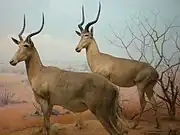
_(31746882054).jpg.webp)

_(30573334994).jpg.webp)
.jpg.webp)
.jpg.webp)
.jpg.webp)
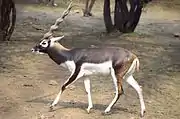
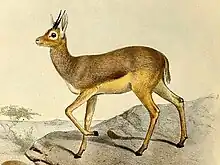
_Gazella_tilonura.png.webp)
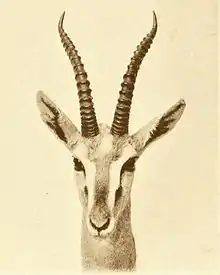
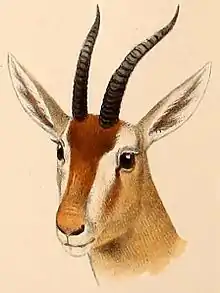
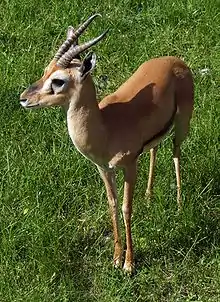

_Gazella_arabica.png.webp)
.jpg.webp)

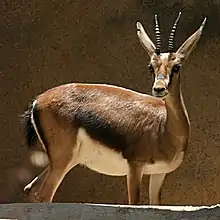
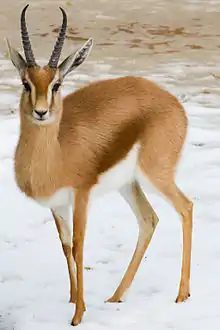
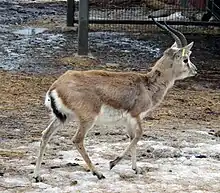
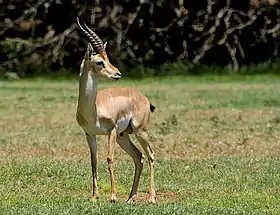
.jpg.webp)
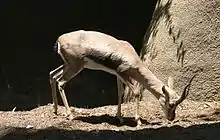
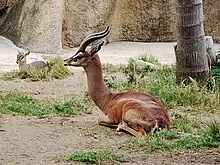
_(7662529270).jpg.webp)
.jpg.webp)
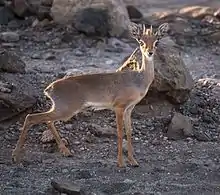
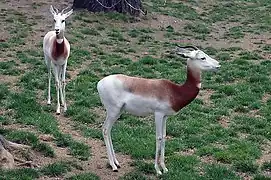

.jpg.webp)
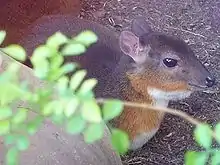
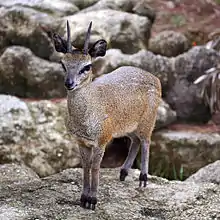
_male_(18172324646).jpg.webp)

_Gazella_gutturosa.png.webp)
_Procapra_przewalskii.jpg.webp)
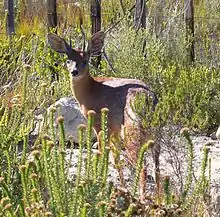
_male_(11838584075).jpg.webp)
.jpg.webp)


.jpg.webp)
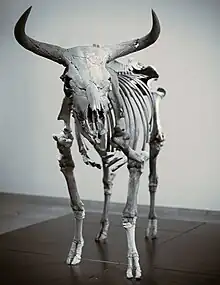

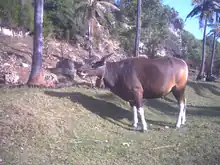
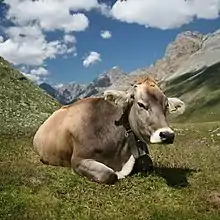

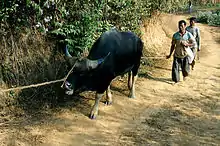
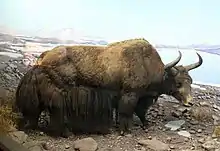


_male.jpg.webp)



.jpg.webp)
_(cropped).jpg.webp)

_male_with_cattle_egret.jpg.webp)

_male.jpg.webp)
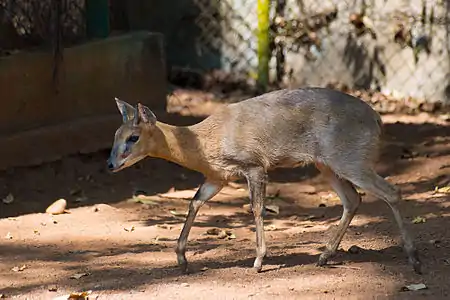


_(6041465641).jpg.webp)
.jpg.webp)
_male.jpg.webp)

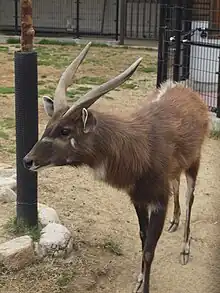


.jpg.webp)
_Zoo_Salzburg_2014_h.jpg.webp)
.jpg.webp)
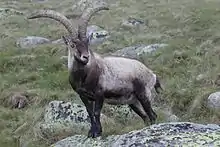

.jpg.webp)
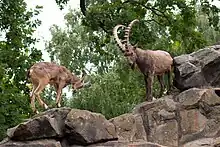
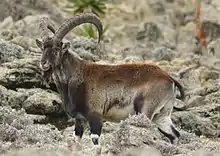


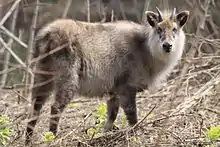

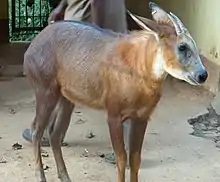




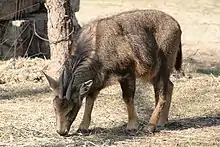


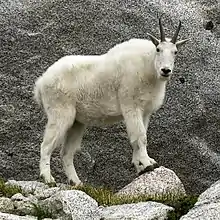
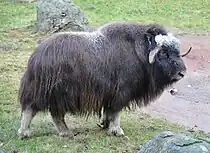

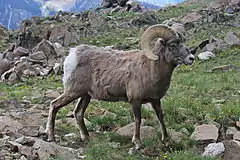


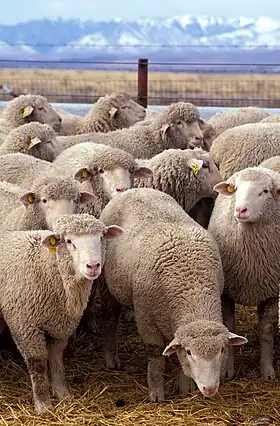
_by_Joseph_Smit.jpg.webp)
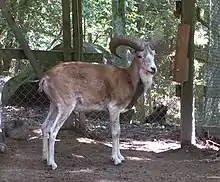
_Pantholops_hodgsoni.png.webp)

_Zoo_Salzburg_2014_g-crop.jpg.webp)
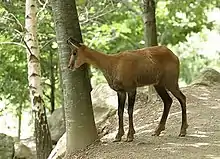
_-_%D7%90%D7%99%D7%95%D7%A8_%D7%A9%D7%9C_%D7%9E%D7%A9%D7%AA%D7%9E%D7%A9-%D7%9E%D7%A0%D7%97%D7%9D.%D7%90%D7%9C.png.webp)
_%D7%90%D7%99%D7%95%D7%A8_%D7%A9%D7%9C_%D7%9E%D7%A9%D7%AA%D7%9E%D7%A9-%D7%9E%D7%A0%D7%97%D7%9D.%D7%90%D7%9C.png.webp)

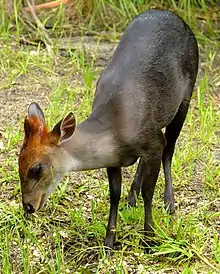
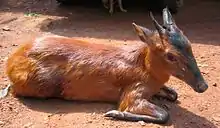
_Cephalophus_jentinki_2.jpg.webp)
_Cephalophus_ogilbyi.png.webp)
_from_behind%252C_Campo_Maan_National_Park.jpg.webp)
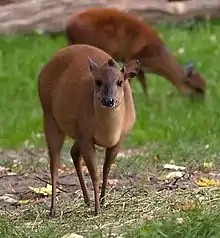
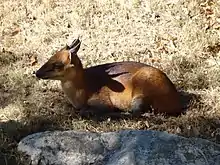
_-_%D7%90%D7%99%D7%95%D7%A8_%D7%A9%D7%9C_%D7%9E%D7%A9%D7%AA%D7%9E%D7%A9-%D7%9E%D7%A0%D7%97%D7%9D.%D7%90%D7%9C.png.webp)
_-_%D7%90%D7%99%D7%95%D7%A8_%D7%A9%D7%9C_%D7%9E%D7%A9%D7%AA%D7%9E%D7%A9-%D7%9E%D7%A0%D7%97%D7%9D.%D7%90%D7%9C.png.webp)
_-_%D7%90%D7%99%D7%95%D7%A8_%D7%A9%D7%9C_%D7%9E%D7%A9%D7%AA%D7%9E%D7%A9-%D7%9E%D7%A0%D7%97%D7%9D.%D7%90%D7%9C.png.webp)


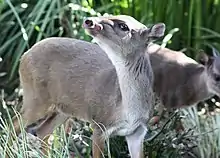
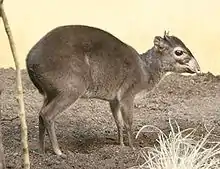

_(6011670419).jpg.webp)


_male.jpg.webp)
_adult_male.jpg.webp)
.jpg.webp)
_female.jpg.webp)
_male.jpg.webp)



.jpg.webp)
_male.jpg.webp)
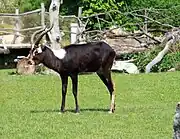

_male.jpg.webp)
_(32453042900).jpg.webp)

_(33043612376).jpg.webp)
_iSimangaliso_Wetland_Park%252C_KwaZulu-Natal%252C_South_Africa.jpg.webp)